02-20 NOVEMBER 2023
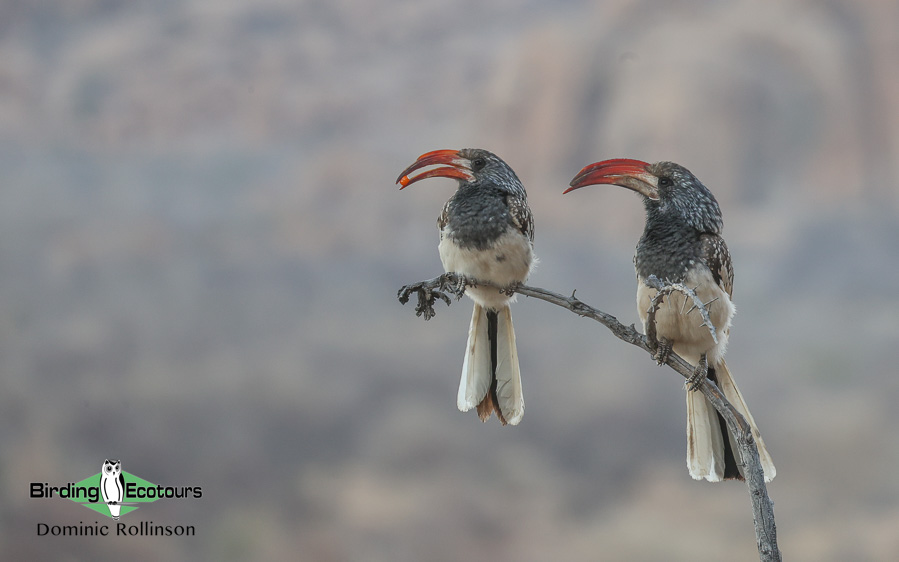
This pair of Monteiro’s Hornbills posed beautifully for us in the Erongo Mountains.
Overview
This Complete Namibia birding itinerary was designed to run during Covid-times, when travel limitations were in place and border crossings were even more of an inconvenience than normal. After running this tour successfully in 2021, we decided that it would be worthwhile to keep this tour running as an alternative to our Namibia, Okavango and Victoria Falls birding tour. After arriving in Namibia, this tour does not leave the country and takes you from the coastal Namib Desert, all the way east to the lush Zambezi Region (formerly the Caprivi Strip) on the banks of the mighty Zambezi River. Although this is a birding tour, we also aim for some fantastic encounters with other wildlife, with these non-birding highlights including our safari drive in Etosha National Park and leopard- and pangolin-tracking in Okonjima Nature Reserve.
This Namibia birding tour is designed to target most of Namibia’s near-endemic birds (shared with Angola or South Africa) and to seek out several other most-wanted and iconic African bird species. During our time in central and northern Namibia we focused on these Namibian near-endemics, while during our time in the Zambezi Region we focused our efforts on more widespread (but range-restricted in Namibia) subtropical species, including a few tough miombo specials.
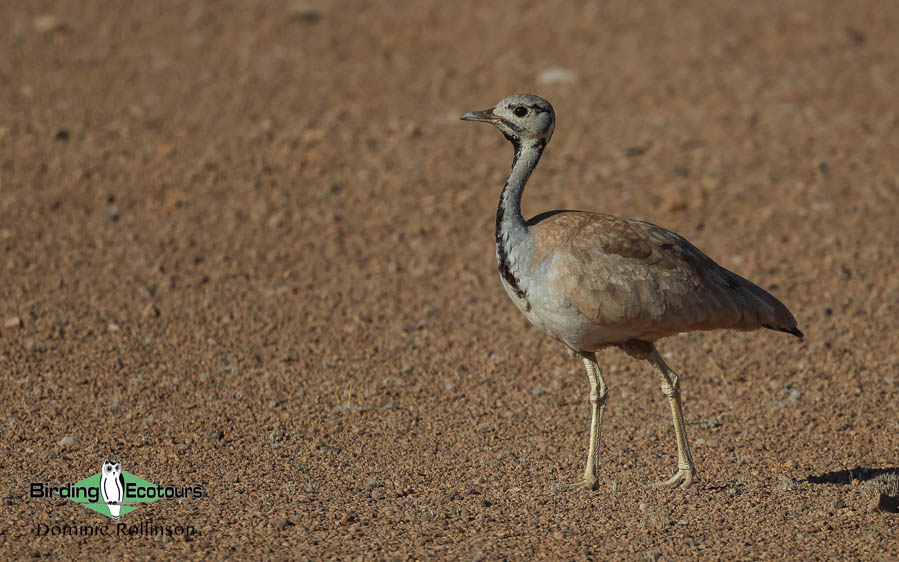
Rüppell’s Korhaan, a striking Namibian near-endemic.
Some of the trip’s many avian highlight species included Hartlaub’s Spurfowl, Cape Gannet, Secretarybird, Western Banded Snake Eagle, Ayres’s Hawk-Eagle, Ludwig’s Bustard, Rüppell’s Korhaan, Wattled Crane, Burchell’s Courser, African Skimmer, Burchell’s Sandgrouse, Racket-tailed Roller, Violet Wood Hoopoe, Damara Red-billed, Bradfield’s and Monteiro’s Hornbills, Pygmy Falcon, Rüppell’s Parrot, Herero Chat, Rockrunner, White-tailed Shrike, Souza’s Shrike, many near-endemic lark species, Bare-cheeked Babbler, Sharp-tailed Starling, Arnot’s Chat, Copper Sunbird and Brown Firefinch, amongst many others.
As on any wildlife trip to Namibia, mammals featured strongly on this tour and we enjoyed sightings of Temminck’s Ground Pangolin, Black Mongoose, Spotted Hyena, Lion, Leopard, (Hartmann’s) Mountain Zebra, African Elephant, Black and White Rhinoceroses, African Buffalo, Roan Antelope, Southern Oryx and Kirk’s Dik-dik.

This large male Lion was seen well in Etosha National Park.
Detailed Report
Day 1, 2nd November 2023. Windhoek birding
With all the guests having arrived in Windhoek during the previous few days, we decided to get a good start to our Namibia birding tour and took an early morning walk around the bushveld surrounding our lodge. The birding started well when we managed to get good views of Rockrunner, a bird that can prove tricky to find, as well as Red-billed Spurfowl, Barred Wren-Warbler, Short-toed Rock Thrush, Black-faced and Violet-eared Waxbills, Green-winged Pytilia and Lark-like Bunting.
After an enjoyable breakfast we took a drive to the nearby Avis Dam, where we scanned the shoreline for a vagrant Great Snipe, which had been seen recently, but was unfortunately not around for us. While scanning the shoreline and looking through the waterfowl we found South African Shelduck, Blue-billed and Cape Teals, Cape Shoveler, Mallard (a tricky bird in Namibia), Maccoa Duck, Red-knobbed Coot, Kittlitz’s Plover and Common and Wood Sandpipers. In the surrounding bush we found White-backed Mousebird, Common Scimitarbill, Monteiro’s Hornbill, Acacia Pied Barbet, Rosy-faced Lovebird, Cape Penduline Tit, Groundscraper Thrush, Kalahari Scrub Robin, Short-toed Rock Thrush, Marico Flycatcher and Great Sparrow. A flock of aerial feeders overhead produced Alpine, Bradfield’s, Little, African Palm and White-rumped Swifts.
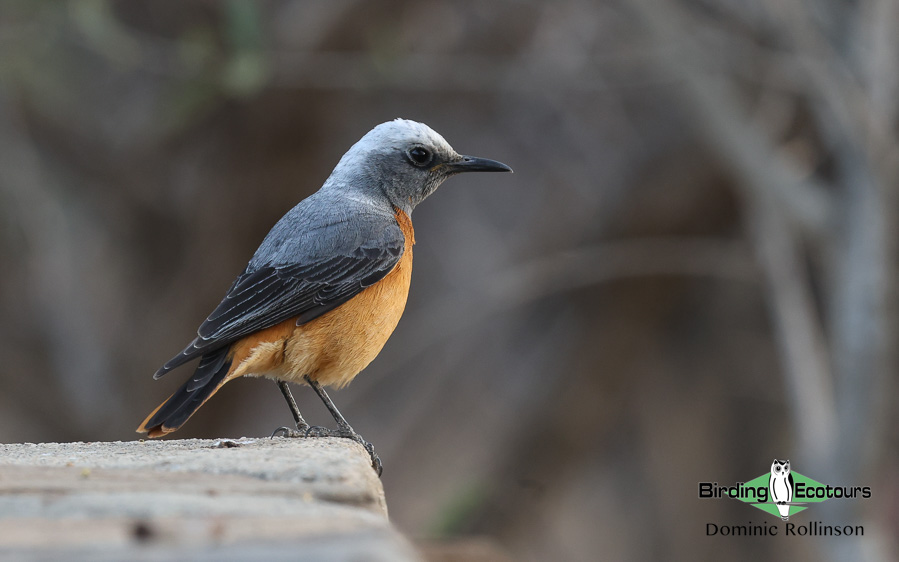
Short-toed Rock Thrushes (such as this male) were abundant across the dry areas of Namibia.
After lunch back at our lodge we took a drive to Gammams Water Care Works, on the other side of Windhoek, which proved very productive with around 65 species seen here for the afternoon. Some of the higher-quality birds seen here included Blue-billed Teal, Namaqua Dove, Black Stork (a long distance away, perched on a pylon), Little Bittern (missed by most unfortunately), Striated and Squacco Herons, Red-faced Mousebird, Damara Red-billed Hornbill, Swallow-tailed Bee-eater, Cardinal Woodpecker, Black-chested Prinia, Common Reed Warbler, Pearl-breasted and White-throated Swallows, Marico Sunbird, Red-billed Firefinch, Buffy Pipit and Yellow Canary. We also had our first looks at large and impressive Chacma Baboons this afternoon. We ended the day relishing a drink on the lodge’s deck as we enjoyed the sunset and did our first evening checklist session.
Day 2, 3rd November 2023. Windhoek to Sossusvlei area
We had another early morning walk around the lodge’s surrounding bushveld which produced a similar mix to the previous morning, ate breakfast and then packed the van for the drive west to the Sossusvlei area. Not too far west of Windhoek we had improved views of Pearl-breasted Swallow and our first vultures of the trip, White-backed Vulture, which was soon followed by the large Lappet-faced Vulture. Not so long afterwards we started noticing the massive communal nest of Sociable Weavers and it did not take too long until we found a nest with a pair of Pygmy Falcons nearby. These tiny falcons nest in the Sociable Weavers nests and help themselves to a weaver meal or two – seems a little unfair!
We stopped on top of the Spreegtshoogte Pass and enjoyed the views of the distant plains far below (I heard and briefly saw a Nicholson’s Pipit fly by, but unfortunately nobody else saw it). We then slowly zig-zagged our way down to the plains for our lunch stop. We found a nice shady tree and were relieved and excited to find that a pair of Herero Chats (well spotted by Ron) had the same idea as us and enjoyed prolonged views of this tricky Namibian near-endemic. The birding at our lunch stop was very productive and we further added Mountain Wheatear, Pale-winged Starling, Layard’s Warbler, Yellow-bellied Eremomela, Pririt Batis, Rock Kestrel and had our first of many Northern Black Korhaans nearby.
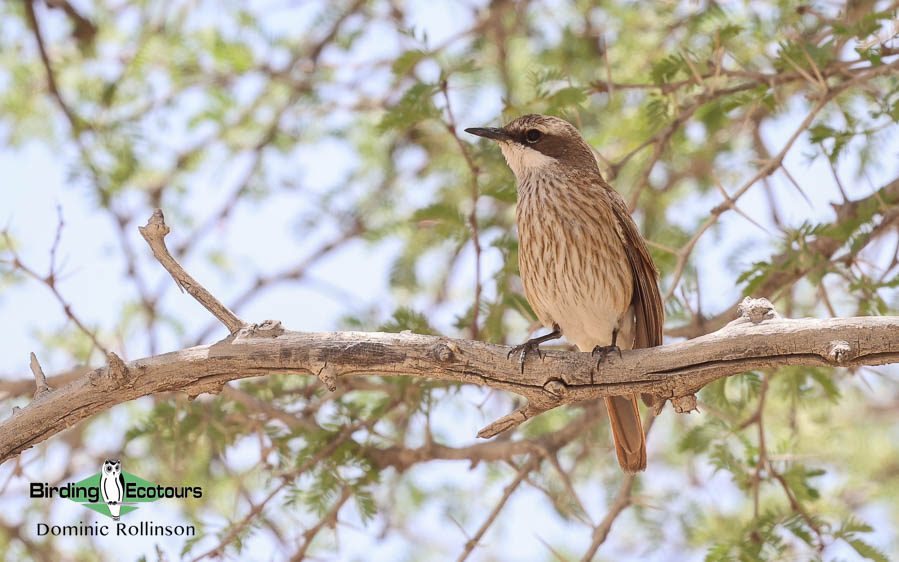
Herero Chat, thankfully, did not put up much of a fight on this trip.
Soon after lunch the scenery began to change and, before we knew it, we were into the desolate plains of the Namib Desert. It did not take long to find our first Rüppell’s Korhaan, soon followed by Greater Kestrel and Karoo Chat.
We checked into our accommodation within the Namib-Naukluft National Park in the early afternoon and enjoyed a few Scaly-feathered Weavers and Pale-winged Starlings near our accommodation. We then headed out to the picturesque Elim Dune, where we searched for Dune Lark (likely to soon be lumped with Barlow’s Lark, meaning Namibia will lose its only endemic bird species). Sadly, despite concerted effort, we could not find this desert dweller. We did, however, enjoy watching the many Wedge-snouted Desert Lizards as they scurried across the red dunes. There was unfortunately not much else of interest in the area, however, we added White-throated Canary and a very showy trio of Rüppell’s Korhaans nearby.

Rüppell’s Korhaan, a striking Namibian near-endemic.
Day 3, 4th November 2023. Sossusvlei birding and sightseeing
This morning we took breakfast packs with us and managed a pre-dawn departure, as we wanted to get to the famous Sossusvlei area before the masses descended and before it heated up too much. On the way to Deadvlei (part pf the Sossusvlei area), we had our first views of Common Ostrich, the largest bird on the planet. We then partook in a good walk out to Deadvlei, where we enjoyed the impressive views of this now cut-off (dead) wetland, complete with the long-dead skeletons of camel thorn trees, making for dramatic views, all with a backdrop of massive red dunes. Once we had admired the impressive scene, we headed back to the vehicle and drove back to our accommodation for lunch. En route back to our lodge, we managed to find a Ludwig’s Bustard (well spotted Pat) and a couple Lappet-faced Vultures which were all sheltering from the intense late-morning heat.
We decided to take some time off during the early- and mid-afternoon heat (Pat and Giselle enjoyed the swimming pool, a routine they kept up for the remainder of the tour!) and then headed out in the late afternoon. We bought some ice creams and took a wander around Sesriem camp, where we were lucky enough to stumble upon two Pygmy Falcons (chicks, I presume) looking down at us from a chamber within a Sociable Weaver nest. We played around with different angles from which to photograph the birds and decided the easiest was to lie down directly under the nest and shoot upwards – an amusing scene for sure!
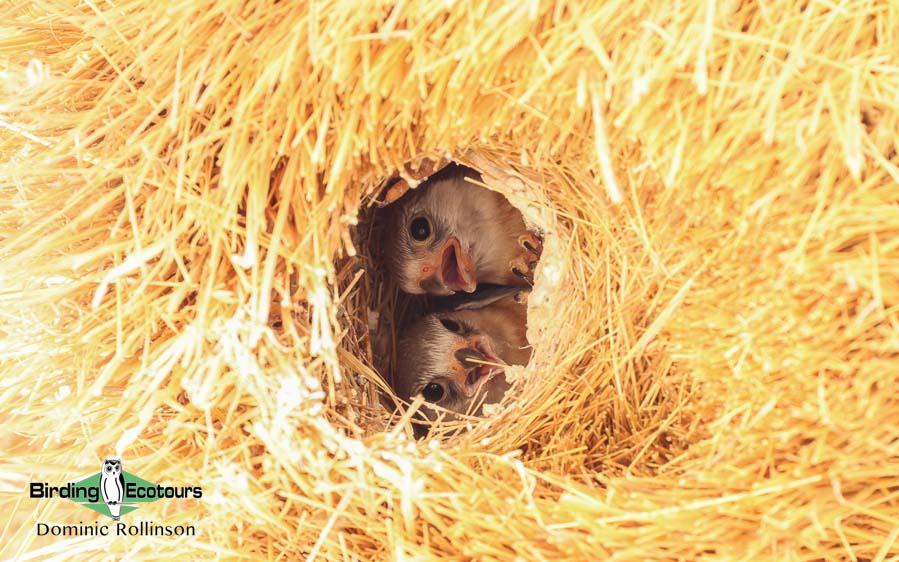
The pair of Pygmy Falcons seen in a Sociable Weaver nest in Sesriem.
After a little while around Sesriem, we took a drive out into the red dunes towards Sossusvlei and at last struck gold when Ron found a single Dune Lark and, eventually, we all managed to get views of a skulking individual. We continued to scan the plains that afternoon for Burchell’s Coursers but, despite spending a lot of time searching, we could not find any of these desert wanderers.
Day 4, 5th November 2023. Sossusvlei birding and transfer to Walvis Bay
This morning we took one last drive through the Namib Desert towards Sossusvlei in the hopes of finding Burchell’s Courser. The coursers again evaded us, nevertheless, we did improve our views of Ludwig’s Bustard and managed a few more Rüppell’s Korhaans, which are always a pleasure to see.
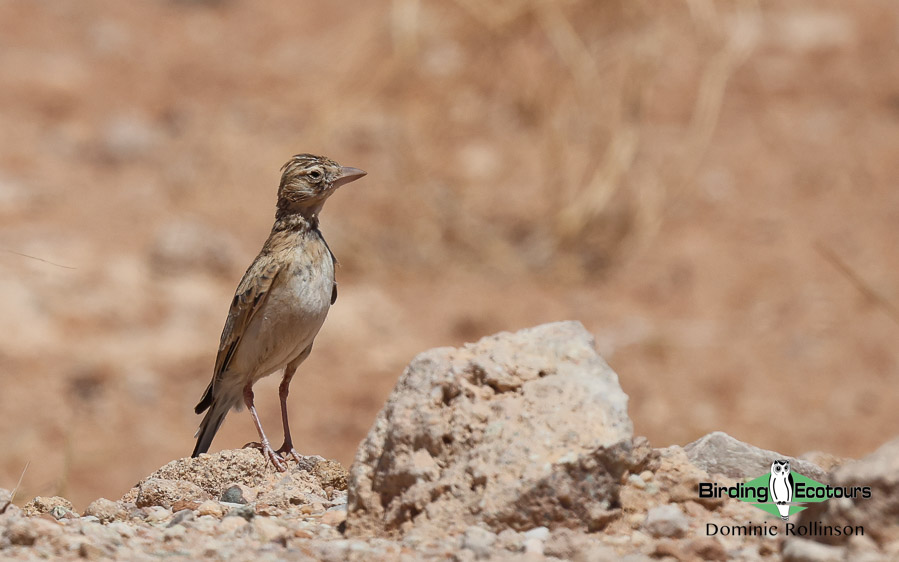
Stark’s Larks were numerous across the desert areas of Namibia.
After breakfast it was time to hit the long (and very bumpy) road to Walvis Bay. Soon after leaving the Sesriem area, we found a Karoo Long-billed Lark at its usual stakeout and saw another pair of Pygmy Falcons nearby. Not far up the road we found a small group of Stark’s Lark, a species which would prove numerous throughout central and northern Namibia on this trip. It was then time to endure the horrible corrugations east of Walvis Bay. After being shaken around for a while, it was a pleasure to join the compacted salt roads as we got closer to the coast and it was in this area that we found a trio of Gray’s Lark, another Namibian near-endemic.
After checking into our accommodation in Walvis Bay (right on the esplanade), we birded the lagoon and then the salt works, just south of town. With such a change in habitat, the new birds came thick and fast, with some of the highlights including African Oystercatcher, Chestnut-banded, Grey, Common Ringed and White-fronted Plovers, Ruddy Turnstone, Pied Avocet, Bar-tailed Godwit, Hartlaub’s Gull, the diminutive Damara Tern and thousands of Greater and Lesser Flamingos.
Day 5: 6th November 2023. Walvis Bay boat cruise and birding
Before breakfast we again birded the esplanade and salt pans, which produced more of the same sightings as the previous afternoon. We also added Common Greenshank, Marsh Sandpiper, Ruff, Sanderling and had better views of Caspian Tern. In the lodge’s garden we managed our first views of Orange River White-eye.
We then headed towards the Walvis Bay small craft harbor, from which we were doing a boat-based tour of Walvis Bay (the large bay itself). Once we had left the dock, it did not take long before we had Great White Pelicans landing on our boat looking for fishy snacks, which were then soon followed by Afro-Australian Fur Seals which too were looking for handouts. The calm conditions allowed us to cruise comfortably around the bay and we enjoyed good sightings of a multitude of exciting coastal and marine birds. Some of the highlights of the roughly three-hour-long boat cruise included South African Shelduck, Black-necked Grebe, Wilson’s Storm Petrel, an unidentified giant petrel (unfortunately we did not get close enough to confirm the species identification), White-chinned Petrel, Sooty Shearwater, Cape Gannet, Crowned and Cape Cormorants and thousands of terns, including Common, Black, Greater Crested, Sandwich and White-winged Terns. Common Bottle-nosed Dolphins entertained us for a while and then, to finish our boat cruise, we enjoyed fresh oysters and some other tasty snacks.
Once back on dry land, we headed north of Walvis Bay and had a quick look around the picturesque town of Swakopmund, where we had closer looks at Cape and Crowned Cormorants (unfortunately no Bank Cormorants were around) and the pretty gardens along the coastal road had good numbers of Orange River White-eyes and a few White-backed Mousebirds.
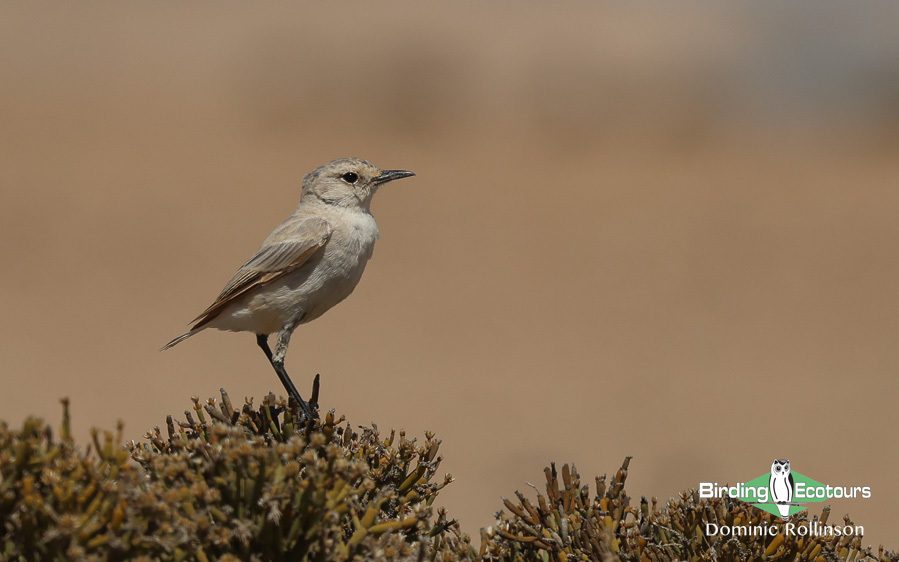
The ghostly white Namib Desert form of Tractrac Chat.
The barren Namib Desert was up next, and we made a special trip out to observe the unique Welwitschia mirabilis plant, which is thought to live to 2,000 years old! This plant species has both male and female plants and acquires water from underground water and desert fog. We alerted Dave (the entomologist in the group) to some interesting and brightly colored bugs crawling about the Welwitschias and, after a quick look online, Dave let us know that they were Probergrothius angolensis (also known as Welwitschia bugs). In the area we also found the ghostly white Namib subspecies of Tractrac Chat.
Day 6, 7th November 2023. Transfer to Erongo Mountain, with Spitzkoppe en route
Armed with breakfast packs, we left our accommodation shortly before sunrise and made our way out into the Namib Desert. Before leaving Walvis Bay, we stopped at the guano platform just north of town to see if we could pick out any Bank Cormorants Unfortunately, the cormorants were still not around, nevertheless, we did add a few vocal Damara Terns which were heading off into the desert, presumably towards their breeding grounds.
The drive through the Namib Desert to Spitzkoppe (the Matterhorn of Africa) was relatively quiet, but the birding picked up soon after turning off the main road. The scattered bushveld held Swallow-tailed Bee-eater, Acacia Pied Barbet, Sabota Lark, and Dusky Sunbird, and birding around the base of the mountain further added Layard’s and Chestnut-vented Warblers, Mountain Wheatear and White-throated Canary. It was a relief to not have to target the tricky Herero Chat (as we had already seen it near Spreegtshoogte Pass) and could simply enjoy the general birding and the impressive views.
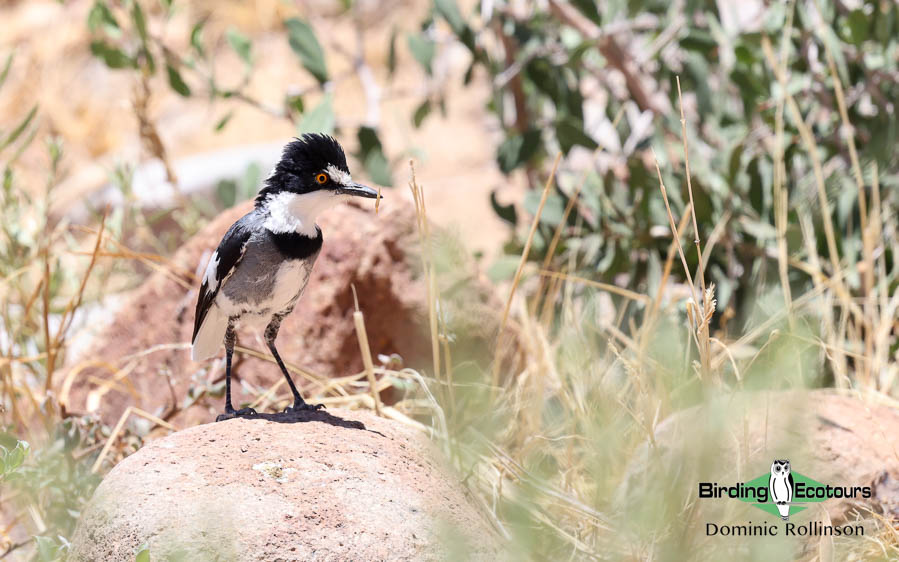
The cute and strikingly patterned White-tailed Shrike was seen in the Erongo Mountains.
The drive northwest to the Erongo Mountains was rather quiet, and when we arrived at our lovely lodge, we enjoyed a sit-down lunch during the extreme heat of the day. While eating our lunch we made acquaintance with some of the area’s special birds, in the form of White-tailed Shrike, Monteiro’s Hornbill, Red-billed Spurfowl and Green-winged Pytilia.
We then took it easy for a little while, before going for a drive in the late afternoon, where we birded a dry river bed which held Southern Pied Babbler, Pririt Batis, Pearl-spotted Owlet, Common Scimitarbill and Grey-backed Camaroptera. An obliging pair of Double-banded Sandgrouse posed for photos nearby too.
Once it had cooled further, we took a little walk from our lodge and birded the bushes around the base of the granite outcrops. The birding was more productive here and we soon found Rosy-faced Lovebird, White-tailed Shrike, Crimson-breasted Shrike, Carp’s Tit, Yellow-bellied Eremomela, Marico Sunbird, Black-throated Canary and Cape Bunting. We had hoped to find Hartlaub’s Spurfowl on this walk but, unfortunately, they did not make a peep for us to try track them down.
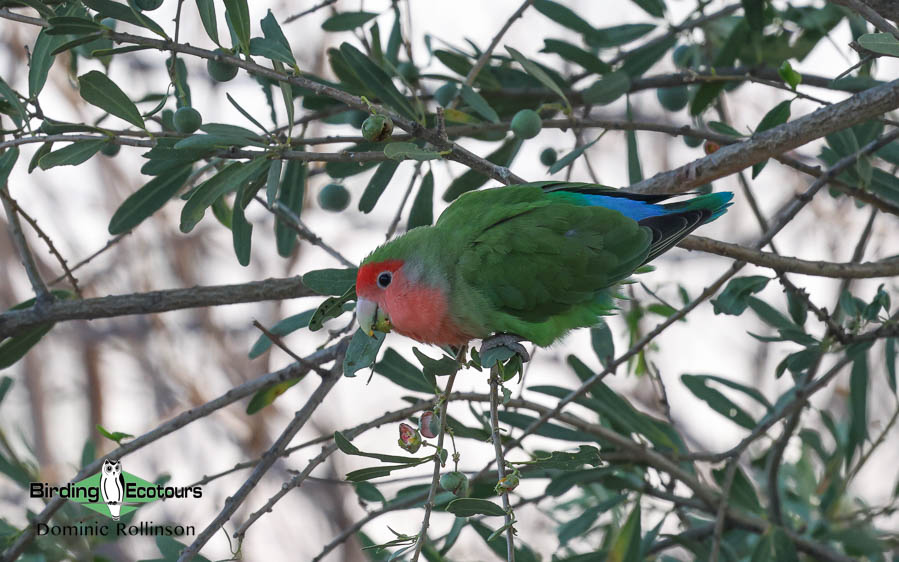
The colorful Rosy-faced Lovebird was an early tour highlight.
Later that evening we enjoyed a wonderful meal, complete with distractions in the form of dozens of Double-banded Sandgrouse coming into drink and a few Freckled Nightjars calling and flitting about catching flying insects.
Day 7, 8th November 2023. Erongo Mountains birding
Hartlaub’s Spurfowl was high on the agenda for this morning’s birding ventures, however, despite looking high and low around all its regular haunts, we drew a blank. The other birding was very productive and highlights included Monteiro’s Hornbill, White-tailed Shrike, Pririt Batis, Great Sparrow and Long-billed Crombec.
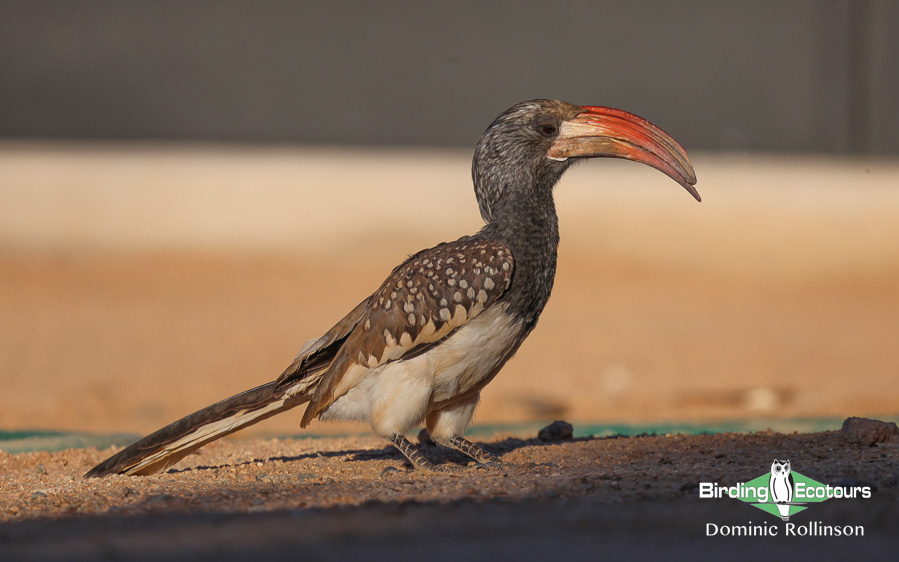
Monteiro’s Hornbill are always obliging and photogenic in the Erongo Mountains.
After a lovely breakfast and before it heated up too much, we took another walk around in the hopes of finding the spurfowl, but were still unsuccessful. Again, the birding was good, and we saw African Hawk-Eagle, Gabar Goshawk, Carp’s Tit, Short-toed Rock Thrush and White-browed Scrub Robin. We all enjoyed seeing the brightly colored male Namibian Rock Agamas scurrying around the boulders near the lodge.
With the heat now intense, we decided to take it easy until the early afternoon. We headed out for an air-conditioned drive (in the van) to a dry river bed in the hopes of finding the near-endemic Rüppell’s Parrot. Along the drive we had nice views of Bearded Woodpecker, Monteiro’s Hornbill and Crimson-breasted Shrike. Birding in the dry river bed was mostly quiet, until we heard the screeches of a single Rüppell’s Parrot, which proved tricky to find but we eventually all had good scope views. Some nearby bird calls led us across the dry river, where we found a small bird party, including Common Scimitarbill, African Grey and Southern Yellow-billed Hornbills, Bearded Woodpecker, White-tailed Shrike, Southern Pied Babbler, Black-backed Puffback, Crimson-breasted Shrike and Groundscraper Thrush.
We then headed back to our lodge (adding the massive Kori Bustard, well spotted by Gerd, en route) and again had another go at finding Hartlaub’s Spurfowl, which sadly still did not play ball for us. The big highlight of the day, however, came when we were sat doing our daily checklist in the early evening and noticed that the Rock Hyrax were making excited alarm calls. We walked out and, before we knew it, we saw a female Leopard dragging her hyrax prey up the boulders and out of sight. What a way to end the day!
Day 8, 9th November 2023. Transfer to Etosha National Park
This morning, we yet again set out to find Hartlaub’s Spurfowl which, of course, proved tricky. After much perseverance (and some help from some other birders at the lodge) we managed to find a pair of spurfowl feeding quietly in the leaf litter and had some great views. We then enjoyed another delicious breakfast, packed the van and started making our way north towards Etosha National Park. A noteworthy mammal was a couple of sightings of the range-restricted Black Mongoose.
The drive was again mostly uneventful, although a few roadside stops produced sightings of Pale Chanting Goshawk, Purple Roller, Tawny Eagle, White-backed and Lappet-faced Vultures, Rüppell’s Parrot (a catchup bird for Danny) and more Monteiro’s Hornbills.
We made our way into Etosha National Park in the early afternoon heat, checked into our accommodation in Okaukuejo Camp and then took it easy until it cooled down a bit. While sorting out accommodation we bumped into a few nice birds, including African Hoopoe, Ashy Tit, Red-headed Finch and a vocal African Cuckoo.
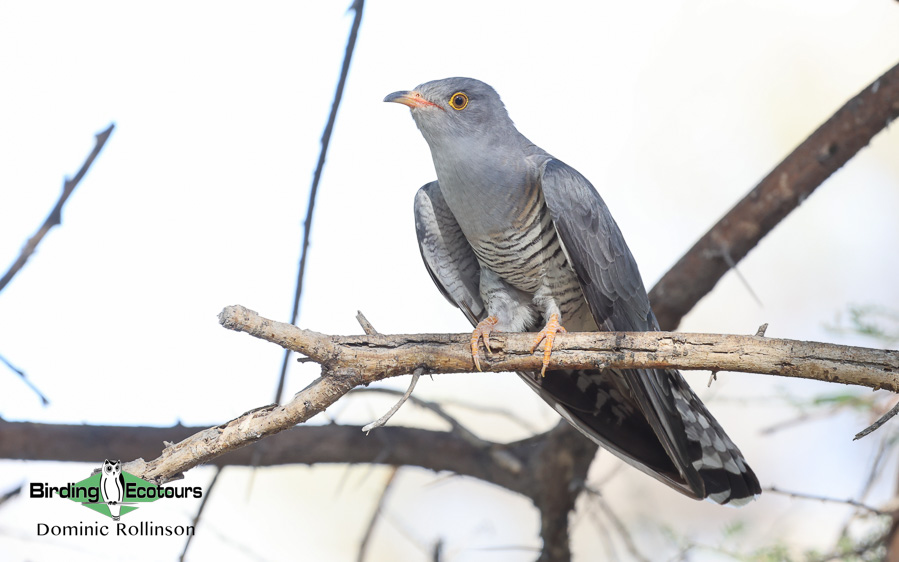
This vocal African Cuckoo was very obliging in Etosha National Park.
A bit later in the afternoon we headed out for a drive north of camp and birded the open plains on the edge of the dry pan. Interesting birds on our drive included Spotted Thick-knee, Double-banded Courser, Greater Kestrel, Red-necked Falcon, Cape Crow, Spike-heeled and Red-capped Larks and Ant-eating Chat. We saw a few exciting animals on this drive too, including Gemsbok (Southern Oryx), Giraffe, Steenbok and a small pride of Lion, sheltering from the harsh sun.
Later that evening, while watching the floodlit waterhole, we saw a few Black Rhinoceros and African Elephant coming down to drink and bathe. Unfortunately, the regular Rufous-cheeked Nightjars were not around tonight.
Day 9, 10th November 2023. Etosha National Park birding and wildlife viewing
We were excited to board our open-top safari vehicle for a drive around Etosha this morning, and it proved to be a fun-filled morning out. Some of the birding highlights included Northern Black Korhaan (many), Kori Bustard, Double-banded Courser, Crowned Lapwing, Tawny Eagle, Lappet-faced Vulture, Greater Kestrel, Stark’s and Pink-billed Larks, Grey-backed Sparrow-Lark, Chat and Marico Flycatchers, Rufous-eared Warbler, Desert Cisticola and Capped Wheatear. A large male Lion stole the show, giving us prolonged, close-up views. Other animals of interest included Common Wildebeest and Steenbok.
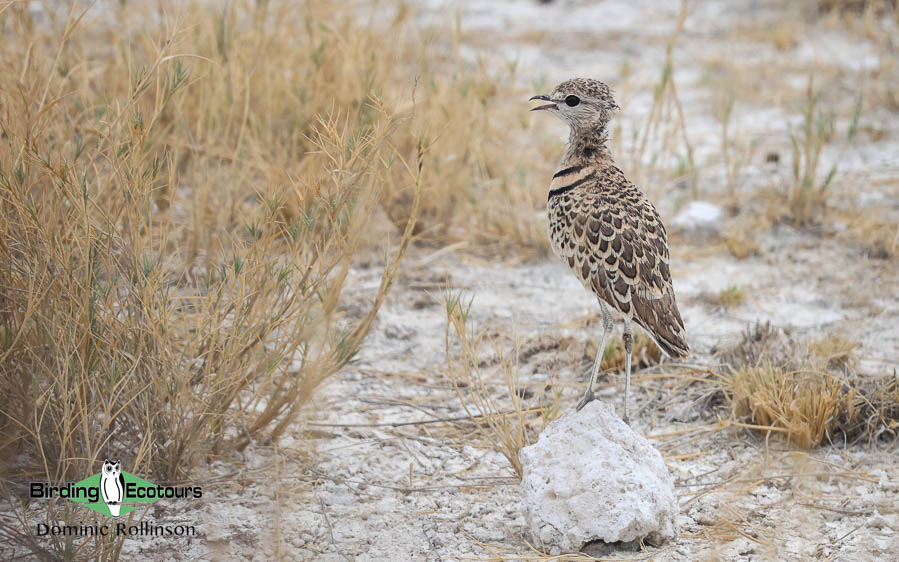
Etosha National Park must be one of the best places around to see Double-banded Courser.
We enjoyed a sit-down lunch at Okaukuejo and, while waiting for lunch, managed to add Southern White-crowned Shrike and Southern Masked Weavers nearby. After lunch and a break from the heat, we headed out for an afternoon drive, this time south of camp, where we birded the open plains and visited a few waterholes. We enjoyed good views of Namaqua Sandgrouse (surprising that it had taken so long to find this species), Wahlberg’s Eagle, Tawny Eagle, Stark’s Lark, European Bee-eater and Yellow Canary. The highlight of the afternoon was undoubtedly the small group of Burchell’s Coursers that we managed to see. Unfortunately, the coursers were seen at quite a distance and some of the group missed the birds when they ran over a rise and out of sight, and despite us making a concerted effort to find them again.
A quick look at the waterhole when we got back to camp produced a few nice water birds, such as Little Grebe, Wood Sandpiper, Common Greenshank, Ruff and Black-headed Heron. Unfortunately, a nocturnal visit after dinner still did not deliver any Rufous-cheeked Nightjars (the extremely windy conditions certainly did not help our cause).
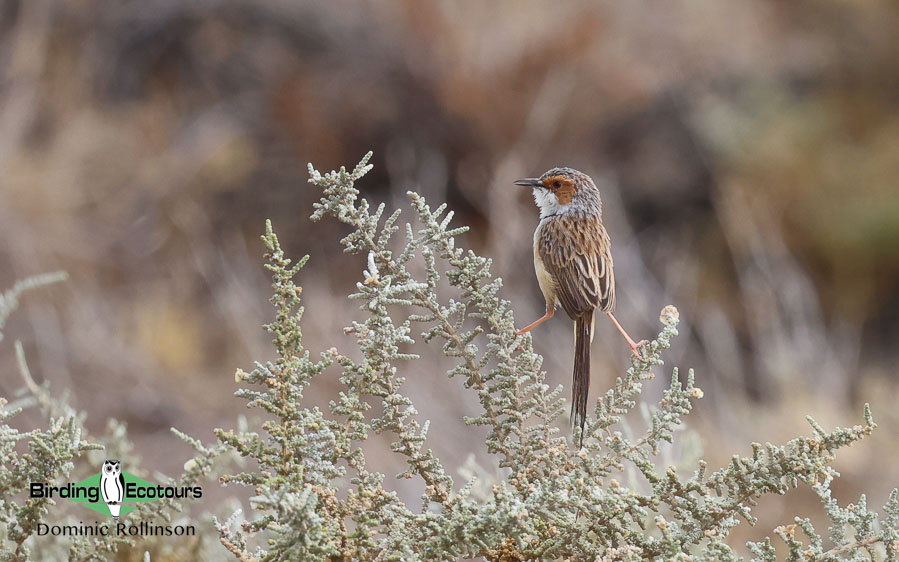
Rufous-eared Warblers occur in low densities throughout the plains of Etosha National Park.
Day 10, 11th November 2023. Etosha National Park birding and wildlife viewing
We had the whole day to make our way east through the park but had a lot of birds and other wildlife to look for en route and thus got moving early (you might notice a theme developing here). Soon after leaving camp, we bumped into a showy Red-crested Korhaan which obliged for us, and we then managed to improve our views of Rufous-eared Warbler and Desert Cisticola soon after. While we were waiting for the above warbler to show, we saw a few displaying Eastern Clapper Larks as they rose vertically out of the low vegetation, clapping their wings loudly together before parachuting back down again. Other new birds along the initial stretch of the drive included Rufous-naped Lark, Common Swift and Red-breasted Swallow. Spotted Hyena and (Red) Hartebeest were other notable sightings on this morning’s drive.
In the late morning, we made it to Halali Camp where we had a good walk around and looked for our two main targets: Violet Wood Hoopoe and Bare-cheeked Babbler. Both the wood hoopoe and babbler proved straightforward and we found them without too much effort. As always, the camp was very birdy and other species we found included Shikra, Southern White-crowned Shrike, Southern Red-billed Hornbill (as well as Damara x Southern Red-billed hybrids), Red-headed Weaver and Cape Starling.
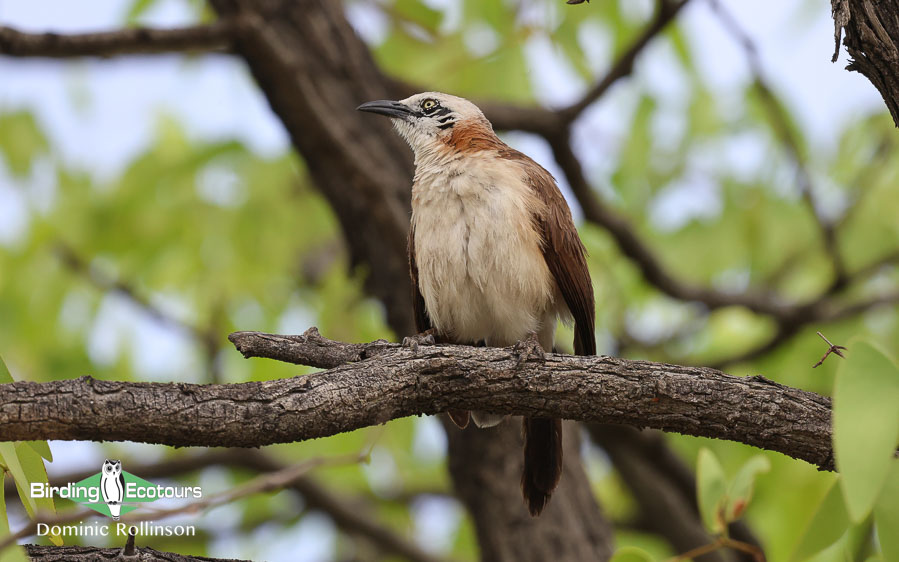
Bare-cheeked Babbler is very reliable in Etosha’s Halali Camp.
Carrying on east, we saw more of the same birds from the previous two days, and eventually found a Secretarybird, which we watched as it went about hunting in the open plains. We arrived at Namutoni for our lunch and had a short wander around camp, where we added Willow Warbler, Burchell’s Starling and White-bellied Sunbird.
After a long day driving through the park, we made it into our beautiful lodge on the eastern border of the park and, after some time off, took a walk around the lush lodge grounds where we soon found Crested Francolin, Grey Go-away-bird, African Palm Swift, Golden-tailed Woodpecker, Yellow-breasted Apalis, Red-billed Buffalo Weaver and our main target, Black-faced Babbler.
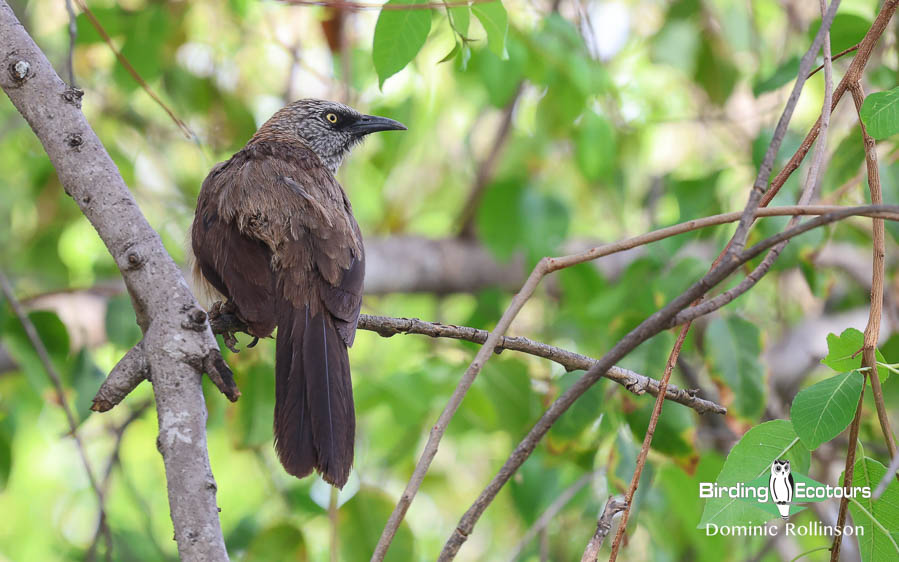
Black-faced Babbler was one of the five babbler species seen on this Namibia tour.
Day 11, 12th November 2023. Transfer to Rundu
Another walk around the lodge grounds this morning proved very productive, as we continued to find new birds in the form of Emerald-spotted Wood Dove, Black Cuckoo, Little Sparrowhawk, White-crested Helmetshrike and African Paradise Flycatcher. We noticed a commotion coming from a large group of birds and, on closer inspection, found a medium-sized African Rock Python coiled up in a tree, presumably trying to raid birds’ nests, but the local birds were onto this one!
We then packed up and made our way towards Rundu, a long drive east. Soon after leaving, we came across massive flocks of Common Swifts. We’ll never know the exact number of birds seen; Ken (an admitted under-estimator) went with 1,000 birds, while I (an admitted over-estimator) thought around 10,000, in the end we decided on 5,000 for the eBird list! As we made our way further and further east, the habitat gradually became lusher and the open plains were replaced with tall woodlands, which meant we started seeing a few new bird species. New birds included Purple and Lilac-breasted Rollers, Yellow-fronted Tinkerbird, Black Cuckooshrike, Southern Black Flycatcher and Scarlet-chested Sunbird.
In the early afternoon we made it to our lodge, a little west of Rundu, and situated right on the banks of the Okavango River. We didn’t waste any time before heading out for a walk around camp which, together with some relaxed birding around camp throughout the afternoon, produced African Pygmy Goose, Collared Pratincole, Emerald-spotted Wood Dove, Grey Go-away-bird, Senegal Coucal, Levaillant’s and Jacobin Cuckoos, Western Barn Owl (at its day roost), Little Bee-eater, Black-collared Barbet, Greater Honeyguide, Swamp Boubou, Orange-breasted Bushshrike, Terrestrial Brownbul, Yellow-bellied Greenbul, Hartlaub’s and Arrow-marked Babblers and Holub’s Golden Weaver, with the vagrant Ross’s Turaco (which has been here a few years now) being the top sighting of the afternoon. That evening we heard Square-tailed Nightjars singing as we enjoyed our dinner but, unfortunately, we could not see any of them, for now.
Day 12, 13th November 2023. Transfer to Katima Mulilo
We had a long drive ahead of us today, but nevertheless still had the morning to bird around our lodge on the edge of the Okavango River, which proved productive. Highlights of the morning’s birding included White-browed Coucal, Collared Pratincole, African Openbill, African Cuckoo-Hawk (only seen by some of the group), African Goshawk, Eurasian Hobby, Meyer’s Parrot, Eurasian Golden Oriole, Red-headed Weaver and a surprise group of Chestnut Weavers, which seemed a little out of range this far east.
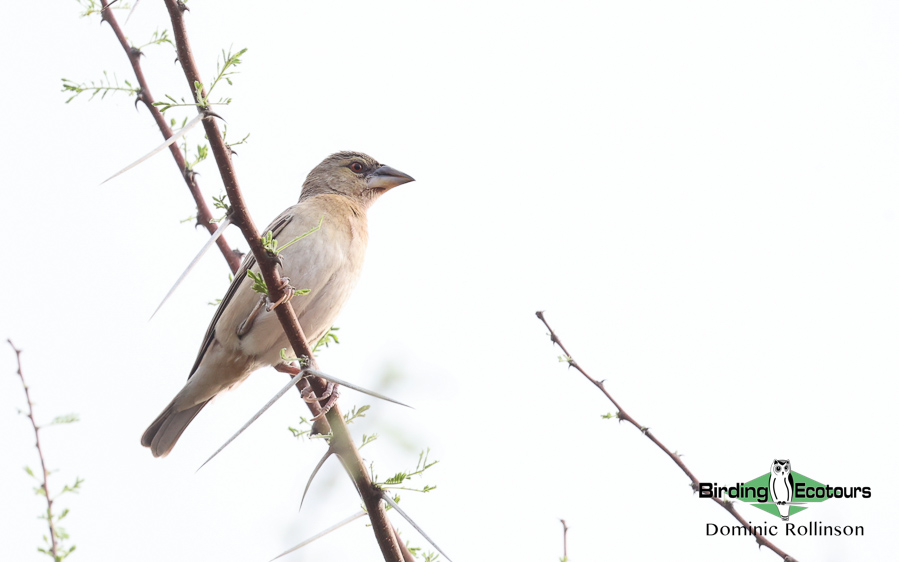
Although not the most striking of birds, non-breeding Chestnut Weavers were exciting to see around Rundu.
After breakfast we packed the van and started the long drive east through the Zambezi Region. We made a couple of birding stops here and there, en route to Katima Mulilo, which did not result in too much of interest but did add our first Yellow-throated Bush Sparrows of the trip. We eventually made it into our lodge in Katima Mulilo in the late afternoon, and we were soon out again on a relaxing boat cruise down the Zambezi River. This was the perfect way to end the day after a long day in the vehicle, and the new birds soon started rolling in. The primary target on this boat cruise was African Finfoot, which did not take much effort to find, with other highlights including Water Thick-knee, White-crowned Lapwing, African Skimmer, roosting White-backed Night Herons, Striated Heron, a roosting Eurasian Nightjar, Giant and Brown-hooded Kingfishers, many Southern Carmine Bee-eaters, Tropical Boubou and Wire-tailed Swallow. Some of the group also managed brief looks at Cape Clawless Otter, while we all saw a few Nile Crocodiles along the river.
We then enjoyed our dinner (with great looks at African Wood Owl as a quick distraction), however, the day was not yet done, and we headed out for some night birding, which proved to be some of the most productive birding of the trip. For a long while, we only heard various owl and nightjar species but then, eventually, they started to show themselves. We saw African Barred Owlet, Western Barn Owl, African Scops Owl and Southern White-faced Owl along with Square-tailed, Fiery-necked and a magnificent male Pennant-winged Nightjar. We got back to our accommodation later that night tired but exhilarated, after a wonderful evening and day’s birding.
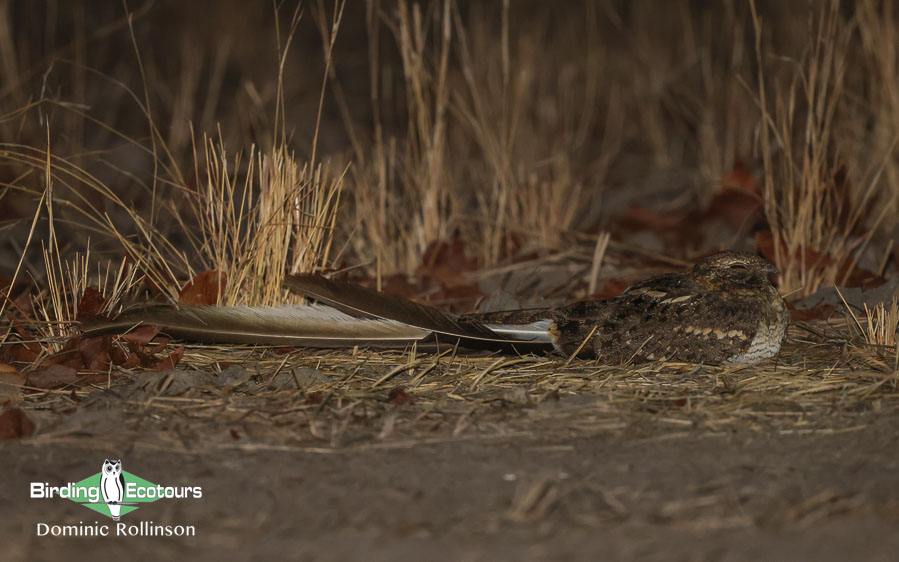
This superb male Pennant-winged Nightjar was one of the many highlights of our nocturnal birding around Katima Mulilo.
Day 13, 14th November 2023. Katima Mulilo birding
We started the morning with a walk from our lodge and birded along the river and the lush riverside woodlands, which produced African Green Pigeon, Schalow’s Turaco, Coppery-tailed Coucal, African Emerald Cuckoo (heard only), African Skimmer, Green Wood Hoopoe, Broad-billed Roller, Crested Barbet, Yellow-fronted Tinkerbird, Olive Woodpecker, Black-crowned Tchagra, Grey-headed Bushshrike, Purple-banded Sunbird and Southern Brown-throated Weaver. We then ventured out to some nearby woodlands, where we targeted Yellow-throated Leaflove, which was only discovered breeding in Namibia in the last decade. The leafloves were located quickly, and we enjoyed prolonged views of a preening bird. Other quality birds seen here included Western Banded Snake Eagle, Trumpeter Hornbill, Tropical Boubou and Holub’s Golden Weaver.
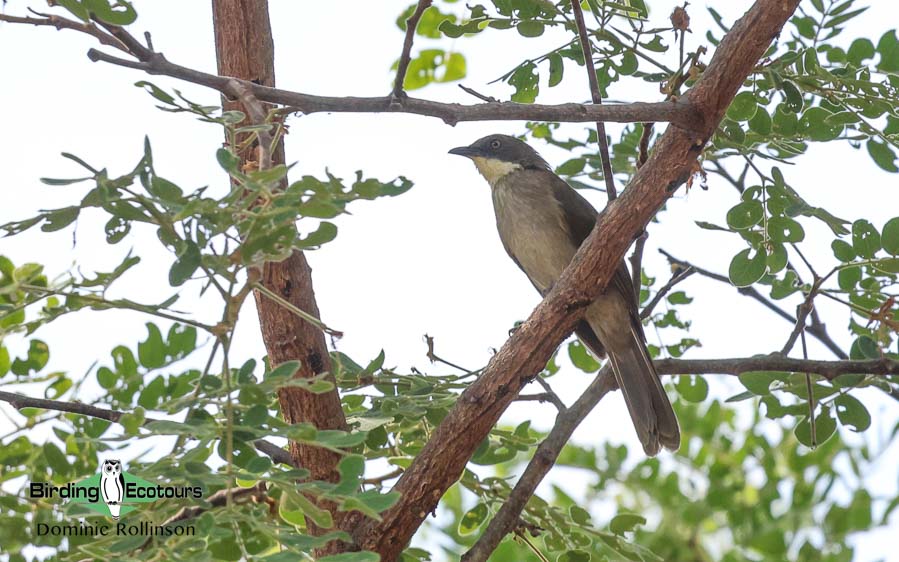
Yellow-throated Leaflove was one of our main targets around Katima Mulilo.
After a late sit-down breakfast (distracted by Red-billed and Brown Firefinches and Bronze Mannikin on the bird table) we again birded some nearby woodlands, which further produced Brubru, White-crested Helmetshrike, Little Bee-eater, Marico Sunbird and Cinnamon-breasted Bunting. We then enjoyed some time off, from the late morning until early afternoon, with a leisurely lunch in between.
In the mid-afternoon we took a drive southeast towards the Botswana border post and birded the Chobe floodplain, which produced some fine new birds for the trip. As we birded the open wetland areas, we soon found Collared Pratincole, Whiskered Tern, Yellow-billed Stork, Hamerkop, Squacco Heron, Great and Intermediate Egrets, Goliath Heron, Glossy Ibis and an assortment of waders including Marsh, Common and Wood Sandpipers, Ruff, Common Greenshank and Little Stint. The heavily grazed grasslands produced Black-bellied Bustard, Coppery-tailed Coucal, Grey-rumped Swallow, Sand Martin, Red-billed and Yellow-billed Oxpeckers, Plain-backed Pipit and brief looks at Rosy-throated Longclaw, which did not behave as we had hoped. The neighboring woodlands further added the likes of Gabar Goshawk, Southern Carmine Bee-eater, Lilac-breasted Roller, Bearded Woodpecker, Meyer’s Parrot, Lesser Grey Shrike, Burnt-necked Eremomela and Greater Blue-eared Starling.
We had planned to do a night boat cruise along the Zambezi River to look for the elusive and rare Pel’s Fishing Owl this evening but, unfortunately, a massive thunderstorm rolled in and, for safety reasons, we had to abort the trip.
Day 14, 15th November 2023. Transfer to Mahango area
We were still missing a few broad-leafed woodland species and so this morning we headed to a patch of such woodland and had but 40 minutes of very enjoyable birding. We started the morning with a showy Grey-headed Kingfisher before the distinctive cries of Racket-tailed Roller were heard nearby, which resulted in lovely views of this scarce species. Other good birds seen here included Red-chested Cuckoo, African Grey Hornbill, African Golden Oriole, Chinspot Batis, White-crested and Retz’s Helmetshrikes and Red-headed Weaver.
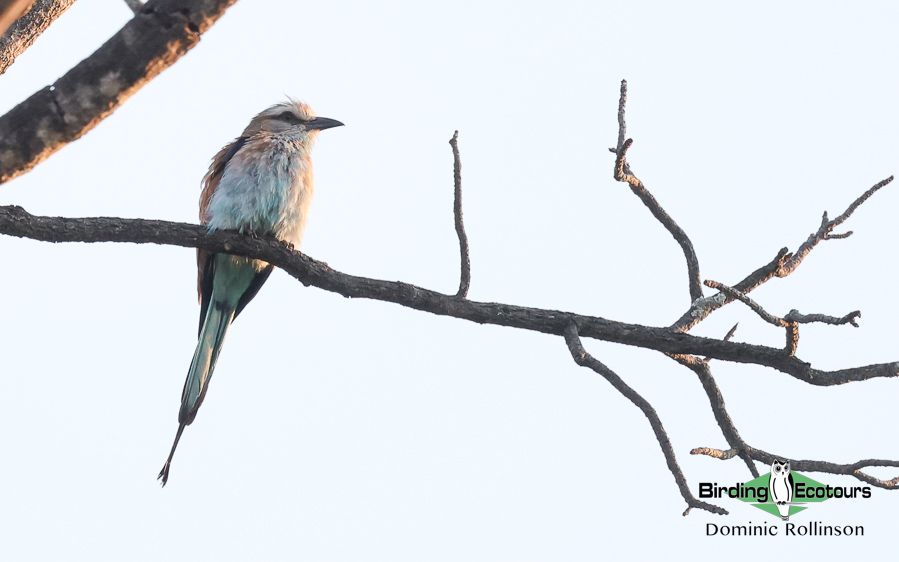
Racket-tailed Roller was seen in tall broad-leafed woodland near Katima Mulilo.
Next, we birded some open woodland closer to camp, where we found Little Sparrowhawk, Green Wood Hoopoe, Crested Barbet, Yellow-fronted Tinkerbird, Grey-headed Bushshrike, four roosting Square-tailed Nightjars, and then struck gold with a lovely male Copper Sunbird.
Our final spot of pre-breakfast birding took us to a nearby wetland which is normally full of birds, and today was no different. Highlights of this area included Knob-billed Duck, African Pygmy Goose (much improved views than before), Long-toed Lapwing, Lesser Jacana, Rufous-bellied Heron, African Marsh Harrier and Fan-tailed Widowbird.
After a busy morning’s birding, we enjoyed a sit-down breakfast, packed the van and started making our way back west through the Zambezi Region. We tried a patch of riverine forest, which has been known to occasionally hold roosting Pel’s Fishing Owls, but, unfortunately, it was not to be and we had to accept defeat with this large ginger owl! As we left Katima Mulilo we did, however, find a pair of obliging Northern Grey-headed Sparrows, new for the trip.
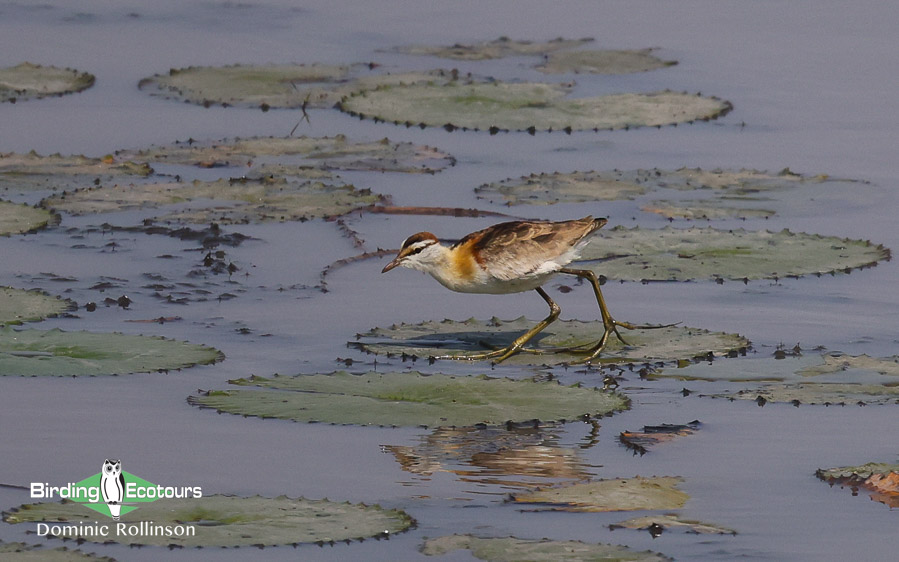
The dainty Lesser Jacana showed well in the wetlands near Katima Mulilo.
The drive westward was uneventful, however, we did add Marabou and Saddle-billed Storks, Brown Snake Eagle and Meve’s Starling. We arrived at our lovely lodge, on the banks of the Okavango River, in the late afternoon and decided to have the rest of the afternoon at leisure. Most of us gathered on the deck overlooking the river and enjoyed a drink, as a huge thunderstorm rolled by. We, of course, had our optics nearby and throughout the afternoon, saw Knob-billed Duck, Spur-winged Goose, White-browed Coucal, African Wattled Lapwing, Rock Pratincole, White-fronted Bee-eater and Lesser Masked Weaver. Kristian spotted a Malachite Kingfisher, which we all missed – amazingly this turned out to be the only sighting of this species of the whole trip!
Day 15, 16th November 2023. Mahango birding
This morning was a particularly early start as we headed about 45 miles (70 kilometers) west of Divundu to bird some dry broad-leafed woodlands for a few very special birds. At our first stop we were met by a local villager (Kosmos) who excitedly showed us his resident Sharp-tailed Starlings, which showed well for us. Next up, Kosmos took us across a field where, after a bit of a search, we found a breeding pair of Arnot’s Chats. We heard the harsh cry of a Souza’s Shrike very nearby but, annoyingly, could not find this rare shrike, despite a good search of the area. Other exciting birds seen in the area included Black Cuckoo, Collared Pratincole, Dark Chanting Goshawk, Eurasian Hobby, Purple Roller, Bearded Woodpecker, Meyer’s Parrot, Black-headed Oriole, Mosque Swallow, Southern Black Flycatcher and Long-tailed Paradise Whydah.
We then tried another patch of woodland, which again proved productive and (while dodging rain squalls) we steadily ticked off new birds such as Brown-backed Honeybird, Green-capped Eremomela, Tinkling Cisticola, Southern Yellow White-eye and an obliging pair of Souza’s Shrikes, which showed well for us.
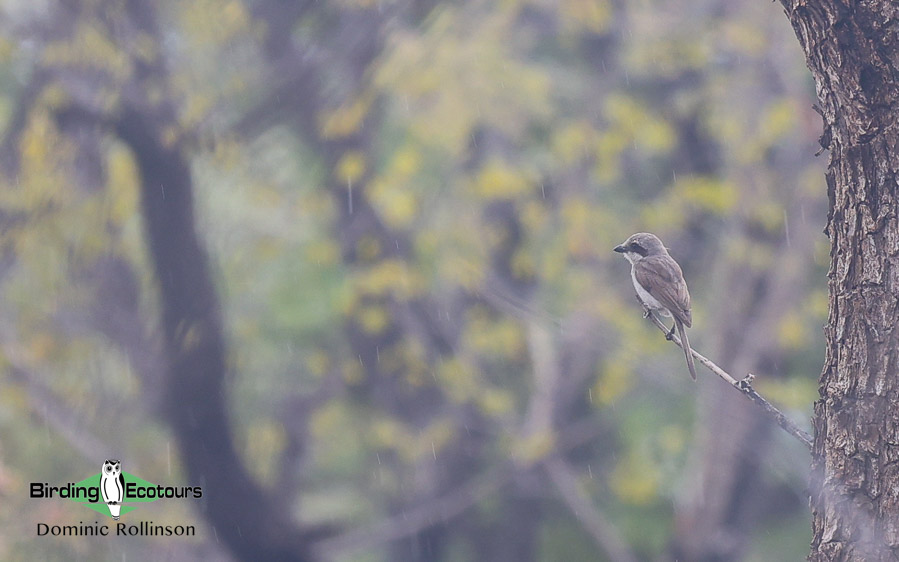
Souza’s Shrike in the woodlands near Divundu.
We made a couple stops on the way back, which added Rock Pratincole, Blue-cheeked Bee-eater, Red-billed Quelea, White-winged Widowbird, Shaft-tailed Whydah and Black-throated Canary to the morning’s already impressive bird list. After an enjoyable morning’s birding we headed back to our accommodation (adding Lesser Spotted Eagle, Wahlberg’s Eagle, Common Buzzard and an immature Ayres’s Hawk-Eagle en route), where we had a pleasant lunch and then some time off. Mourning Collared Doves were seen wandering around camp after we had finished our lunch.
Later that afternoon we headed out to Mahangu Game Reserve, which is right on the Botswanan border, and offers some fine birding and game viewing. Today was no different as we saw some great birds such as Swainson’s Spurfowl, Coppery-tailed Coucal, Wattled Crane, Long-toed Lapwing, Woolly-necked Stork, Marabou Stork, Common Scimitarbill, Woodland Kingfisher, Swallow-tailed Bee-eater, Bennett’s Woodpecker, Crimson-breasted Shrike, Fawn-colored Lark, Banded Martin, Black-faced Babbler and Violet-eared Waxbill. An interesting find was a group of around a dozen Stark’s Larks which were very out of range this far east! As always, the floodplain was littered with animals, including Common Warthog, Hippopotamus, Southern Lechwe, Plains Zebra, Giraffe, African Buffalo and Kudu, with a herd of Roan Antelope seen in the woodlands on our way out of the reserve.
Day 16, 17th November 2023. Mahango birding, and transfer to Grootfontein
This morning, we had an exciting boat cruise down the Okavango River, which met expectations and proved to be a highly enjoyable couple of hours out on the water. Our first stop was a nearby Southern Carmine Bee-eater colony, where we enjoyed point-blank views of the bee-eaters as they returned to their nest holes. A bonus here was views of a single vagrant Northern Carmine Bee-eater which has now returned for its second season here. Other noteworthy species seen during our boat cruise included Knob-billed Duck, Mourning Collared Dove, Coppery-tailed and White-browed Coucals, Black Crake, Sanderling (seemingly a little out of range here), African Skimmer, Whiskered Tern, Grey-headed Kingfisher, Village Weaver and Yellow-crowned Bishop.
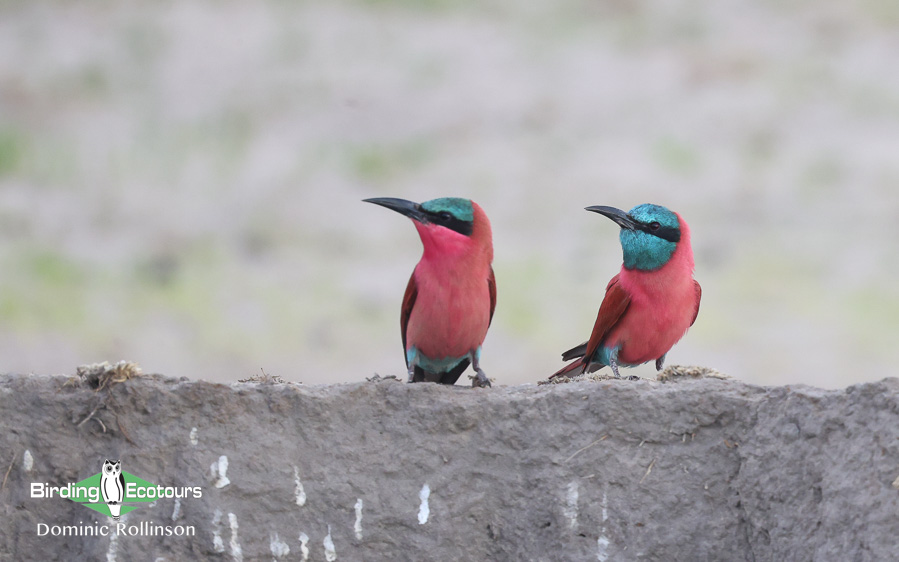
Southern (left) and Northern Carmine Bee-eaters at the breeding colony along the Okavango River.
After breakfast we packed up and started making our way back west. We decided to have another stop in the same woodlands a little west of Divundu to see if we could find the hoped-for Rufous-bellied Tit, but sadly again drew a blank here. The birding was good and we found Tinkling Cisticola, Neddicky, Icterine Warbler, Southern Yellow White-eye, Pale Flycatcher, Yellow-fronted Canary and I had brief views of White-breasted Cuckooshrike which, unfortunately, nobody else got onto properly.
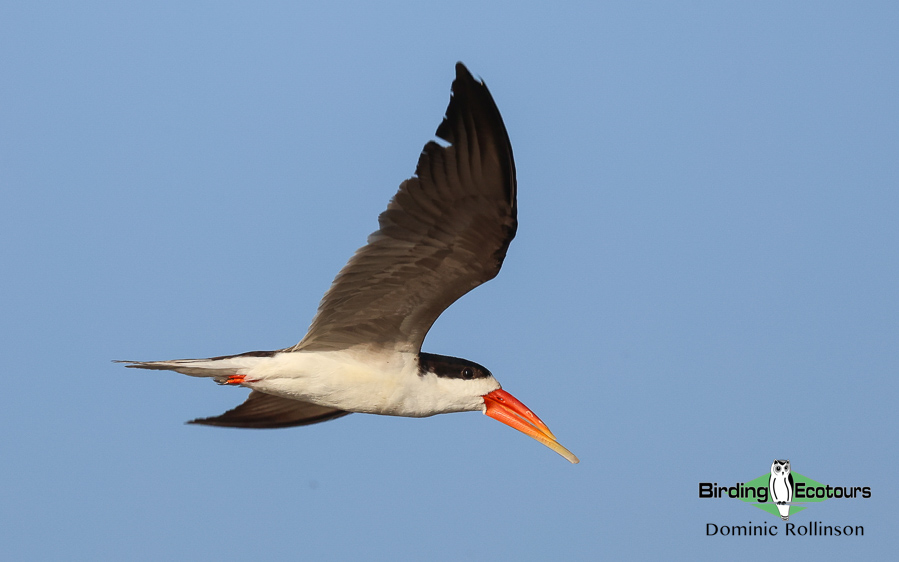
African Skimmers were seen along the major rivers on this Namibia birding tour.
Later that afternoon we made it to our lovely lodge just outside of Grootfontein, where we enjoyed a very birdy walk around in the late afternoon. Some of the highlights included Red-billed Spurfowl, Red-crested Korhaan, Spotted Thick-knee, Southern Yellow-billed Hornbill, Acacia Pied Barbet, Brubru, Burnt-necked Eremomela, Red-billed Buffalo Weaver and Red-headed Finch.
Day 17, 18th November 2023. Transfer to Okonjima Nature Reserve
Before breakfast this morning we had another walk around the game farm which proved a little on the quiet side, however, we did manage to find Red-crested Korhaan, Namaqua Dove, Gabar Goshawk, Common Scimitarbill, Cardinal Woodpecker, Cape Penduline Tit, Green-winged Pytilia and more small groups of Stark’s Larks. After breakfast and on our way out, we finally got lucky with views of Bradfield’s Hornbill, with African Grey, Southern Red-billed and Southern Yellow-billed Hornbills also seen in the immediate area.
From Grootfontein area we made our way south, with a couple birding stops en route, which produced Lesser Striped Swallow, Zitting and Desert Cisticolas, Rufous-naped Lark, Brown Snake Eagle and African Pipit.
For our lunch break we stopped at Otjiwarongo Sewage Works, which was full of birds. It had been a while since our last visit to a sewage works and so naturally everybody was excited to see what was around! Highlights here included Blue-billed and Red-billed Teals, Little Grebe, Alpine, Little and African Palm Swifts, Red-knobbed Coot, African Swamphen, Black-crowned Night Heron, Common Reed Warbler, and I managed brief views of Sedge Warbler, which was unfortunately missed by the group.
We eventually arrived at Okonjima Nature Reserve in the mid-afternoon (finding White Rhino on the drive in). We met later in the afternoon to enjoy a relaxed drink as we watched the sun go down over the waterhole. There were, of course, many birds around here and we managed to find Namaqua and Double-banded Sandgrouses, Tawny Eagle, Gabar Goshawk, African Hoopoe, Crimson-breasted Shrike, Marico Flycatcher and Marico Sunbird. Animals were also abundant, coming down for a drink at the waterhole, and included Black-backed Jackal, (Hartmann’s) Mountain Zebra, Common Warthog, Gemsbok, Impala, Springbok and Kirk’s (Damara) Dik-dik.
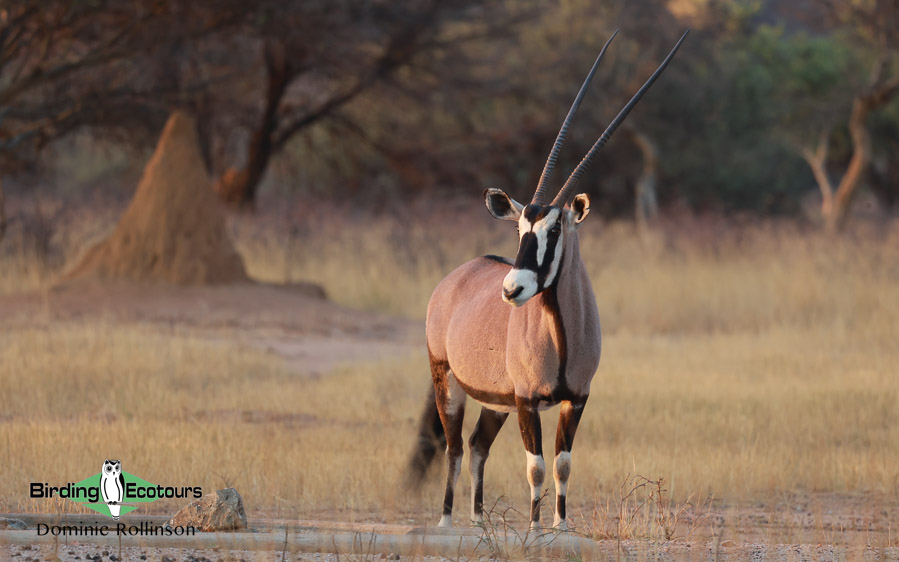
The attractive Gemsbok struck quite a pose in Okonjima Nature Reserve.
After a wonderful dinner, we found out that the fun was not yet over, as a radio-tagged Temminck’s Ground Pangolin had been found nearby. We loaded up into the vehicle and made our way over (seeing Scrub Hare en route) and arrived at the spot, where we watched the pangolin as it quietly fed in the undergrowth. These gentle creatures are under serious threat due to the illegal (and senseless) trade in their scales. We all felt privileged to watch this bizarre animal go about its business as we learnt about their interesting biology from our informative guide. While we enjoyed the pangolin, Rufous-cheeked Nightjars called all around us, with thunder rumbling in the distance, making it a very atmospheric experience. What a way to end another fun day in Namibia!
Day 18, 19th November 2023. Okonjima Nature Reserve birding and wildlife viewing
Today was our final full day of the tour and we headed out again on an open-top game drive, this time tracking radio-tagged Leopards. It did not take long to pick up a signal and before we knew it, we had found a big male Leopard casually walking along the road in front of us. The Leopard was seemingly unperturbed by our presence and went about walking the roads on the hunt for any unsuspecting prey.
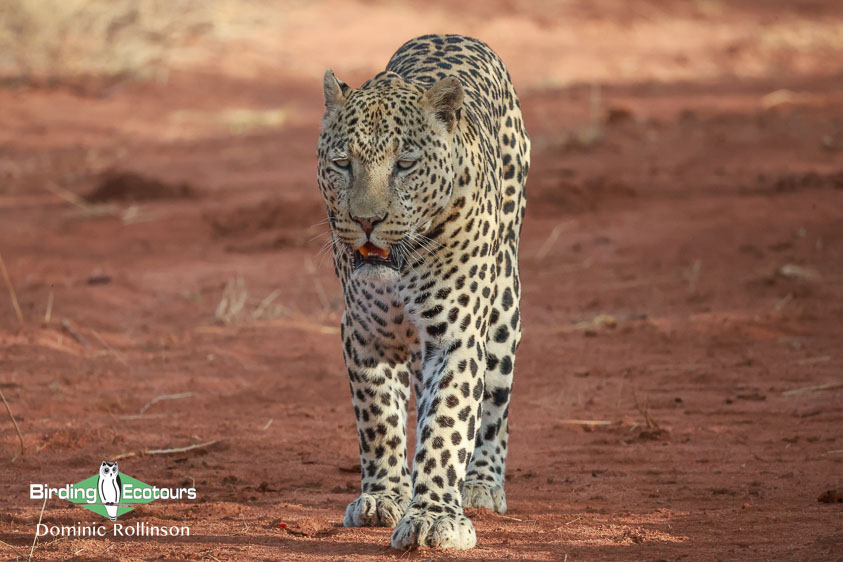
We enjoyed spending time with this Leopard in Okonjima Nature Reserve.
We spent a few productive hours on our drive and racked up an impressive bird list for the morning, including Namaqua Sandgrouse, Red-crested Korhaan, Black-chested Snake Eagle, Tawny Eagle, Damara Red-billed Hornbill, White-tailed Shrike, Pririt Batis, Brown-crowned Tchagra, Rockrunner, Yellow-bellied Eremomela, Barred Wren-Warbler, Icterine Warbler (improved views from yesterday’s brief sighting), Southern Pied Babbler, Chestnut Weaver and Shaft-tailed Whydah.
After a hearty sit-down breakfast, we took a quick drive out along the entrance road. It was a little quiet but did produce sightings of Black-chested Snake Eagle, Kori Bustard, Crowned Lapwing, Monteiro’s Hornbill, Chestnut Weaver and Lark-like Bunting. Non-avian highlights included (Hartmann’s) Mountain Zebra, Giraffe, Kudu and Kirk’s (Damara) Dik-dik.
In the afternoon we birded on foot around a koppie (small conical hill) which was very birdy and provided improved views of several species which we had seen previously on the trip. In a couple of hours birding here we notched up White-tailed Shrike, Pririt Batis, Carp’s and Ashy Tits, Long-billed Crombec, Rockrunner, Barred Wren-Warbler and Violet-eared Waxbill. We were surprised when a Freckled Nightjar suddenly started calling in the broad daylight, but we unfortunately could not find the bird in question.
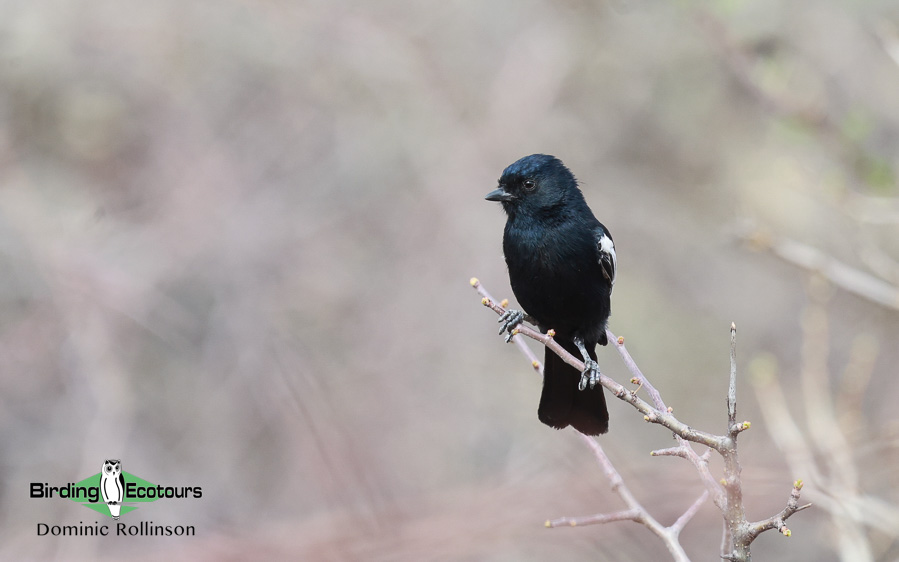
Carp’s Tit, another Namibian near-endemic which was seen in north-central Namibia.
A walk around camp in the early evening added Tawny Eagle, Spotted Eagle-Owl and (at last) a few Burchell’s Sandgrouse, coming down to drink as we did our checklist. We enjoyed our final African sunset before another enjoyable evening meal.
Day 19, 20th November 2023. Transfer to Windhoek and departure
A few of us met up in the early morning for a final walk around camp, which did not produce too much of interest, however, we did manage to find Rüppell’s Parrot, Crimson-breasted Shrike, Ashy Tit, Barred Wren-Warbler and Pearl-breasted Swallow.
After breakfast we loaded up the van one last time and made our way south to Windhoek Airport, where we said goodbye to a few of our group, before heading out for our final bit of birding around Avis Dam, just outside of Windhoek. We were hoping to find Orange River Francolin, which had thus far eluded us, however it was not to be, and we had to settle for more looks at South African Shelduck, Maccoa Duck, Brubru and Black-faced Waxbill.
I then dropped off the remainder of our group at their accommodation just outside of Windhoek, concluding a highly enjoyable 19 days in Namibia. I would like to thank everybody for making it such a successful trip, with some great bird and animal sightings. A special thank you to Ken for his diligent eBirding, which made my life a whole lot easier – I’m not sure you realise how much time you saved me each evening! I look forward to hopefully traveling with you all again in the not-too-distant future
.
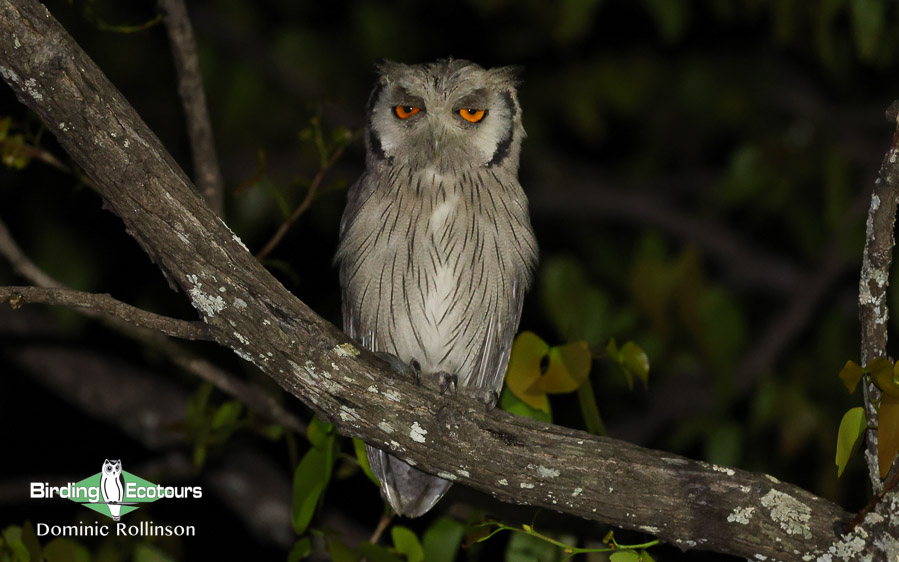
Southern White-faced Owl was one of several owl species seen on this tour.
Bird List – Following IOC (13.2)
Birds ‘heard only’ are marked with (H) after the common name, birds seen by the guide only are marked with a (L) after the common name, all other species were seen both by clients and guide.
The following notation after species names is used to show conservation status following BirdLife International. CR = Critically Endangered, EN = Endangered, VU = Vulnerable.
| Common Name | Scientific Name |
| Ostriches (Struthionidae) | |
| Common Ostrich | Struthio camelus |
| Ducks, Geese, Swans (Anatidae) | |
| White-faced Whistling Duck | Dendrocygna viduata |
| Spur-winged Goose | Plectropterus gambensis |
| Knob-billed Duck | Sarkidiornis melanotos |
| Egyptian Goose | Alopochen aegyptiaca |
| South African Shelduck | Tadorna cana |
| African Pygmy Goose | Nettapus auritus |
| Blue-billed Teal | Spatula hottentota |
| Cape Shoveler | Spatula smithii |
| Yellow-billed Duck | Anas undulata |
| Mallard | Anas platyrhynchos |
| Cape Teal | Anas capensis |
| Red-billed Teal | Anas erythrorhyncha |
| Maccoa Duck – EN | Oxyura maccoa |
| Guineafowl (Numididae) | |
| Helmeted Guineafowl | Numida meleagris |
| Pheasants & Allies (Phasianidae) | |
| Crested Francolin | Ortygornis sephaena |
| Hartlaub’s Spurfowl | Pternistis hartlaubi |
| Red-billed Spurfowl | Pternistis adspersus |
| Swainson’s Spurfowl | Pternistis swainsonii |
| Nightjars (Caprimulgidae) | |
| European Nightjar | Caprimulgus europaeus |
| Rufous-cheeked Nightjar (H) | Caprimulgus rufigena |
| Fiery-necked Nightjar | Caprimulgus pectoralis |
| Freckled Nightjar | Caprimulgus tristigma |
| Square-tailed Nightjar | Caprimulgus fossii |
| Pennant-winged Nightjar | Caprimulgus vexillarius |
| Swifts (Apodidae) | |
| African Palm Swift | Cypsiurus parvus |
| Alpine Swift | Tachymarptis melba |
| Common Swift | Apus apus |
| Bradfield’s Swift | Apus bradfieldi |
| Little Swift | Apus affinis |
| White-rumped Swift | Apus caffer |
| Turacos (Musophagidae) | |
| Grey Go-away-bird | Crinifer concolor |
| Ross’s Turaco | Tauraco rossae |
| Schalow’s Turaco | Tauraco schalowi |
| Bustards (Otididae) | |
| Kori Bustard | Ardeotis kori |
| Ludwig’s Bustard – EN | Neotis ludwigii |
| Denham’s Bustard | Neotis denhami |
| Rüppell’s Korhaan | Heterotetrax rueppelii |
| Red-crested Korhaan | Lophotis ruficrista |
| Northern Black Korhaan | Afrotis afraoides |
| Black-bellied Bustard | Lissotis melanogaster |
| Cuckoos (Cuculidae) | |
| Senegal Coucal | Centropus senegalensis |
| Coppery-tailed Coucal | Centropus cupreicaudus |
| White-browed Coucal | Centropus superciliosus |
| Levaillant’s Cuckoo | Clamator levaillantii |
| Jacobin Cuckoo | Clamator jacobinus |
| Diederik Cuckoo | Chrysococcyx caprius |
| Klaas’s Cuckoo (H) | Chrysococcyx klaas |
| African Emerald Cuckoo (H) | Chrysococcyx cupreus |
| Black Cuckoo | Cuculus clamosus |
| Red-chested Cuckoo | Cuculus solitarius |
| African Cuckoo | Cuculus gularis |
| Sandgrouse (Pteroclidae) | |
| Namaqua Sandgrouse | Pterocles namaqua |
| Double-banded Sandgrouse | Pterocles bicinctus |
| Burchell’s Sandgrouse | Pterocles burchelli |
| Pigeons, Doves (Columbidae) | |
| Rock Dove | Columba livia |
| Speckled Pigeon | Columba guinea |
| Mourning Collared Dove | Streptopelia decipiens |
| Red-eyed Dove | Streptopelia semitorquata |
| Ring-necked Dove | Streptopelia capicola |
| Laughing Dove | Spilopelia senegalensis |
| Emerald-spotted Wood Dove | Turtur chalcospilos |
| Namaqua Dove | Oena capensis |
| African Green Pigeon | Treron calvus |
| Finfoots (Heliornithidae) | |
| African Finfoot | Podica senegalensis |
| Rails, Crakes & Coots (Rallidae) | |
| Common Moorhen | Gallinula chloropus |
| Red-knobbed Coot | Fulica cristata |
| African Swamphen | Porphyrio madagascariensis |
| Black Crake | Zapornia flavirostra |
| Cranes (Gruidae) | |
| Wattled Crane – VU | Grus carunculata |
| Blue Crane – VU | Grus paradisea |
| Grebes (Podicipedidae) | |
| Little Grebe | Tachybaptus ruficollis |
| Black-necked Grebe | Podiceps nigricollis |
| Flamingos (Phoenicopteridae) | |
| Greater Flamingo | Phoenicopterus roseus |
| Lesser Flamingo | Phoeniconaias minor |
| Stone-curlews, Thick-knees (Burhinidae) | |
| Water Thick-knee | Burhinus vermiculatus |
| Spotted Thick-knee | Burhinus capensis |
| Oystercatchers (Haematopodidae) | |
| African Oystercatcher | Haematopus moquini |
| Stilts, Avocets (Recurvirostridae) | |
| Black-winged Stilt | Himantopus himantopus |
| Pied Avocet | Recurvirostra avosetta |
| Plovers (Charadriidae) | |
| Long-toed Lapwing | Vanellus crassirostris |
| Blacksmith Lapwing | Vanellus armatus |
| White-crowned Lapwing | Vanellus albiceps |
| Crowned Lapwing | Vanellus coronatus |
| African Wattled Lapwing | Vanellus senegallus |
| Grey Plover | Pluvialis squatarola |
| Common Ringed Plover | Charadrius hiaticula |
| Kittlitz’s Plover | Charadrius pecuarius |
| Three-banded Plover | Charadrius tricollaris |
| White-fronted Plover | Charadrius marginatus |
| Chestnut-banded Plover | Charadrius pallidus |
| Jacanas (Jacanidae) | |
| Lesser Jacana | Microparra capensis |
| African Jacana | Actophilornis africanus |
| Sandpipers, Snipes (Scolopacidae) | |
| Eurasian Whimbrel | Numenius phaeopus |
| Bar-tailed Godwit | Limosa lapponica |
| Ruddy Turnstone | Arenaria interpres |
| Ruff | Calidris pugnax |
| Curlew Sandpiper | Calidris ferruginea |
| Sanderling | Calidris alba |
| Little Stint | Calidris minuta |
| Common Sandpiper | Actitis hypoleucos |
| Marsh Sandpiper | Tringa stagnatilis |
| Wood Sandpiper | Tringa glareola |
| Common Greenshank | Tringa nebularia |
| Coursers, Pratincoles (Glareolidae) | |
| Burchell’s Courser | Cursorius rufus |
| Double-banded Courser | Rhinoptilus africanus |
| Collared Pratincole | Glareola pratincola |
| Rock Pratincole | Glareola nuchalis |
| Gulls, Terns, Skimmers (Laridae) | |
| African Skimmer | Rynchops flavirostris |
| Grey-headed Gull | Chroicocephalus cirrocephalus |
| Hartlaub’s Gull | Chroicocephalus hartlaubii |
| Kelp Gull | Larus dominicanus |
| Caspian Tern | Hydroprogne caspia |
| Greater Crested Tern | Thalasseus bergii |
| Sandwich Tern | Thalasseus sandvicensis |
| Damara Tern | Sternula balaenarum |
| Common Tern | Sterna hirundo |
| Whiskered Tern | Chlidonias hybrida |
| White-winged Tern | Chlidonias leucopterus |
| Black Tern | Chlidonias niger |
| Austral Storm Petrels (Oceanitidae) | |
| Wilson’s Storm Petrel | Oceanites oceanicus |
| Petrels, Shearwaters, Diving Petrels (Procellariidae) | |
| White-chinned Petrel – VU | Procellaria aequinoctialis |
| Sooty Shearwater | Ardenna grisea |
| Storks (Ciconiidae) | |
| African Openbill | Anastomus lamelligerus |
| Marabou Stork | Leptoptilos crumenifer |
| Yellow-billed Stork | Mycteria ibis |
| Saddle-billed Stork | Ephippiorhynchus senegalensis |
| Black Stork | Ciconia nigra |
| Gannets, Boobies (Sulidae) | |
| Cape Gannet – EN | Morus capensis |
| Anhingas, Darters (Anhingidae) | |
| African Darter | Anhinga rufa |
| Cormorants, Shags (Phalacrocoracidae) | |
| Reed Cormorant | Microcarbo africanus |
| Crowned Cormorant | Microcarbo coronatus |
| Cape Cormorant – EN | Phalacrocorax capensis |
| White-breasted Cormorant | Phalacrocorax lucidus |
| Ibises, Spoonbills (Threskiornithidae) | |
| African Sacred Ibis | Threskiornis aethiopicus |
| Glossy Ibis | Plegadis falcinellus |
| African Spoonbill | Platalea alba |
| Herons, Bitterns (Ardeidae) | |
| Little Bittern | Ixobrychus minutus |
| White-backed Night Heron | Gorsachius leuconotus |
| Black-crowned Night Heron | Nycticorax nycticorax |
| Striated Heron | Butorides striata |
| Squacco Heron | Ardeola ralloides |
| Rufous-bellied Heron | Ardeola rufiventris |
| Western Cattle Egret | Bubulcus ibis |
| Grey Heron | Ardea cinerea |
| Black-headed Heron | Ardea melanocephala |
| Goliath Heron | Ardea goliath |
| Purple Heron | Ardea purpurea |
| Great Egret | Ardea alba |
| Intermediate Egret | Ardea intermedia |
| Little Egret | Egretta garzetta |
| Hamerkop (Scopidae) | |
| Hamerkop | Scopus umbretta |
| Pelicans (Pelecanidae) | |
| Great White Pelican | Pelecanus onocrotalus |
| Secretarybird (Sagittariidae) | |
| Secretarybird – EN | Sagittarius serpentarius |
| Ospreys (Pandionidae) | |
| Osprey | Pandion haliaetus |
| Kites, Hawks, Eagles (Accipitridae) | |
| Black-winged Kite | Elanus caeruleus |
| African Harrier-Hawk | Polyboroides typus |
| African Cuckoo-Hawk | Aviceda cuculoides |
| White-backed Vulture – CR | Gyps africanus |
| Lappet-faced Vulture – EN | Torgos tracheliotos |
| Black-chested Snake Eagle | Circaetus pectoralis |
| Brown Snake Eagle | Circaetus cinereus |
| Western Banded Snake Eagle | Circaetus cinerascens |
| Bateleur – EN | Terathopius ecaudatus |
| Lesser Spotted Eagle | Clanga pomarina |
| Wahlberg’s Eagle | Hieraaetus wahlbergi |
| Ayres’s Hawk-Eagle | Hieraaetus ayresii |
| Tawny Eagle – VU | Aquila rapax |
| African Hawk-Eagle | Aquila spilogaster |
| Gabar Goshawk | Micronisus gabar |
| Dark Chanting Goshawk | Melierax metabates |
| Pale Chanting Goshawk | Melierax canorus |
| African Goshawk | Accipiter tachiro |
| Shikra | Accipiter badius |
| Little Sparrowhawk | Accipiter minullus |
| African Marsh Harrier | Circus ranivorus |
| Yellow-billed Kite | Milvus aegyptius |
| African Fish Eagle | Icthyophaga vocifer |
| Common Buzzard | Buteo buteo |
| Barn Owls (Tytonidae) | |
| Western Barn Owl | Tyto alba |
| Owls (Strigidae) | |
| Pearl-spotted Owlet | Glaucidium perlatum |
| African Barred Owlet | Glaucidium capense |
| African Scops Owl | Otus senegalensis |
| Southern White-faced Owl | Ptilopsis granti |
| Spotted Eagle-Owl | Bubo africanus |
| African Wood Owl | Strix woodfordii |
| Mousebirds (Coliidae) | |
| White-backed Mousebird | Colius colius |
| Red-faced Mousebird | Urocolius indicus |
| Hoopoes (Upupidae) | |
| African Hoopoe | Upupa africana |
| Wood Hoopoes (Phoeniculidae) | |
| Green Wood Hoopoe | Phoeniculus purpureus |
| Violet Wood Hoopoe | Phoeniculus damarensis |
| Common Scimitarbill | Rhinopomastus cyanomelas |
| Hornbills (Bucerotidae) | |
| Damara Red-billed Hornbill | Tockus damarensis |
| Southern Red-billed Hornbill | Tockus rufirostris |
| Monteiro’s Hornbill | Tockus monteiri |
| Southern Yellow-billed Hornbill | Tockus leucomelas |
| Bradfield’s Hornbill | Lophoceros bradfieldi |
| African Grey Hornbill | Lophoceros nasutus |
| Trumpeter Hornbill | Bycanistes bucinator |
| Rollers (Coraciidae) | |
| Purple Roller | Coracias naevius |
| Racket-tailed Roller | Coracias spatulatus |
| Lilac-breasted Roller | Coracias caudatus |
| Broad-billed Roller | Eurystomus glaucurus |
| Kingfishers (Alcedinidae) | |
| Grey-headed Kingfisher | Halcyon leucocephala |
| Brown-hooded Kingfisher | Halcyon albiventris |
| Striped Kingfisher (H) | Halcyon chelicuti |
| Woodland Kingfisher | Halcyon senegalensis |
| Giant Kingfisher | Megaceryle maxima |
| Pied Kingfisher | Ceryle rudis |
| Bee-eaters (Meropidae) | |
| Swallow-tailed Bee-eater | Merops hirundineus |
| Little Bee-eater | Merops pusillus |
| White-fronted Bee-eater | Merops bullockoides |
| Blue-cheeked Bee-eater | Merops persicus |
| European Bee-eater | Merops apiaster |
| Northern Carmine Bee-eater | Merops nubicus |
| Southern Carmine Bee-eater | Merops nubicoides |
| African Barbets (Lybiidae) | |
| Yellow-fronted Tinkerbird | Pogoniulus chrysoconus |
| Acacia Pied Barbet | Tricholaema leucomelas |
| Black-collared Barbet | Lybius torquatus |
| Crested Barbet | Trachyphonus vaillantii |
| Honeyguides (Indicatoridae) | |
| Brown-backed Honeybird | Prodotiscus regulus |
| Lesser Honeyguide | Indicator minor |
| Greater Honeyguide | Indicator indicator |
| Woodpeckers (Picidae) | |
| Bennett’s Woodpecker | Campethera bennettii |
| Golden-tailed Woodpecker | Campethera abingoni |
| Bearded Woodpecker | Chloropicus namaquus |
| Cardinal Woodpecker | Dendropicos fuscescens |
| Olive Woodpecker | Dendropicos griseocephalus |
| Caracaras, Falcons (Falconidae) | |
| Pygmy Falcon | Polihierax semitorquatus |
| Rock Kestrel | Falco rupicolus |
| Greater Kestrel | Falco rupicoloides |
| Red-necked Falcon | Falco chicquera |
| Eurasian Hobby | Falco subbuteo |
| African & New World Parrots (Psittacidae) | |
| Meyer’s Parrot | Poicephalus meyeri |
| Rüppell’s Parrot | Poicephalus rueppellii |
| Old World Parrots (Psittaculidae) | |
| Rosy-faced Lovebird | Agapornis roseicollis |
| Wattle-eyes, Batises (Platysteiridae) | |
| Chinspot Batis | Batis molitor |
| Pririt Batis | Batis pririt |
| White-tailed Shrike | Lanioturdus torquatus |
| Bushshrikes (Malaconotidae) | |
| Grey-headed Bushshrike | Malaconotus blanchoti |
| Orange-breasted Bushshrike | Chlorophoneus sulfureopectus |
| Bokmakierie (H) | Telophorus zeylonus |
| Brown-crowned Tchagra | Tchagra australis |
| Black-crowned Tchagra | Tchagra senegalus |
| Black-backed Puffback | Dryoscopus cubla |
| Tropical Boubou | Laniarius major |
| Swamp Boubou | Laniarius bicolor |
| Crimson-breasted Shrike | Laniarius atrococcineus |
| Brubru | Nilaus afer |
| Vangas & Allies (Vangidae) | |
| White-crested Helmetshrike | Prionops plumatus |
| Retz’s Helmetshrike | Prionops retzii |
| Cuckooshrikes (Campephagidae) | |
| White-breasted Cuckooshrike (L) | Ceblepyris pectoralis |
| Black Cuckooshrike | Campephaga flava |
| Figbirds, Old World Orioles, Piopios (Oriolidae) | |
| Black-headed Oriole | Oriolus larvatus |
| African Golden Oriole | Oriolus auratus |
| Eurasian Golden Oriole | Oriolus oriolus |
| Drongos (Dicruridae) | |
| Fork-tailed Drongo | Dicrurus adsimilis |
| Monarchs (Monarchidae) | |
| African Paradise Flycatcher | Terpsiphone viridis |
| Shrikes (Laniidae) | |
| Southern White-crowned Shrike | Eurocephalus anguitimens |
| Magpie Shrike | Lanius melanoleucus |
| Southern Fiscal | Lanius collaris |
| Lesser Grey Shrike | Lanius minor |
| Red-backed Shrike | Lanius collurio |
| Crows, Jays (Corvidae) | |
| Cape Crow | Corvus capensis |
| Pied Crow | Corvus albus |
| Tits, Chickadees (Paridae) | |
| Southern Black Tit | Melaniparus niger |
| Carp’s Tit | Melaniparus carpi |
| Ashy Tit | Melaniparus cinerascens |
| Penduline Tits (Remizidae) | |
| Cape Penduline Tit | Anthoscopus minutus |
| Larks (Alaudidae) | |
| Spike-heeled Lark | Chersomanes albofasciata |
| Gray’s Lark | Ammomanopsis grayi |
| Karoo Long-billed Lark | Certhilauda subcoronata |
| Grey-backed Sparrow-Lark | Eremopterix verticalis |
| Sabota Lark | Calendulauda sabota |
| Fawn-colored Lark | Calendulauda africanoides |
| Dune Lark | Calendulauda erythrochlamys |
| Eastern Clapper Lark | Mirafra fasciolata |
| Rufous-naped Lark | Mirafra africana |
| Stark’s Lark | Spizocorys starki |
| Pink-billed Lark | Spizocorys conirostris |
| Red-capped Lark | Calandrella cinerea |
| Bulbuls (Pycnonotidae) | |
| Yellow-throated Leaflove | Atimastillas flavicollis |
| Yellow-bellied Greenbul | Chlorocichla flaviventris |
| Terrestrial Brownbul | Phyllastrephus terrestris |
| African Red-eyed Bulbul | Pycnonotus nigricans |
| Dark-capped Bulbul | Pycnonotus tricolor |
| Swallows, Martins (Hirundinidae) | |
| Banded Martin | Neophedina cincta |
| Sand Martin | Riparia riparia |
| Grey-rumped Swallow | Pseudhirundo griseopyga |
| Rock Martin | Ptyonoprogne fuligula |
| Pearl-breasted Swallow | Hirundo dimidiata |
| White-throated Swallow | Hirundo albigularis |
| Wire-tailed Swallow | Hirundo smithii |
| Barn Swallow | Hirundo rustica |
| Red-breasted Swallow | Cecropis semirufa |
| Mosque Swallow | Cecropis senegalensis |
| Lesser Striped Swallow | Cecropis abyssinica |
| Greater Striped Swallow | Cecropis cucullata |
| Crombecs, African Warblers (Macrosphenidae) | |
| Rockrunner | Achaetops pycnopygius |
| Long-billed Crombec | Sylvietta rufescens |
| Leaf Warblers (Phylloscopidae) | |
| Willow Warbler | Phylloscopus trochilus |
| Reed Warblers & Allies (Acrocephalidae) | |
| Lesser Swamp Warbler | Acrocephalus gracilirostris |
| Sedge Warbler (L) | Acrocephalus schoenobaenus |
| Common Reed Warbler | Acrocephalus scirpaceus |
| Icterine Warbler | Hippolais icterina |
| Cisticolas & Allies (Cisticolidae) | |
| Rattling Cisticola | Cisticola chiniana |
| Tinkling Cisticola | Cisticola rufilatus |
| Neddicky | Cisticola fulvicapilla |
| Zitting Cisticola | Cisticola juncidis |
| Desert Cisticola | Cisticola aridulus |
| Tawny-flanked Prinia | Prinia subflava |
| Black-chested Prinia | Prinia flavicans |
| Yellow-breasted Apalis | Apalis flavida |
| Rufous-eared Warbler | Malcorus pectoralis |
| Grey-backed Camaroptera | Camaroptera brevicaudata |
| Barred Wren-Warbler | Calamonastes fasciolatus |
| Yellow-bellied Eremomela | Eremomela icteropygialis |
| Green-capped Eremomela | Eremomela scotops |
| Burnt-necked Eremomela | Eremomela usticollis |
| Sylviid Babblers (Sylviidae) | |
| Layard’s Warbler | Curruca layardi |
| Chestnut-vented Warbler | Curruca subcoerulea |
| White-eyes (Zosteropidae) | |
| Orange River White-eye | Zosterops pallidus |
| Southern Yellow White-eye | Zosterops anderssoni |
| Laughingthrushes & Allies (Leiothrichidae) | |
| Arrow-marked Babbler | Turdoides jardineii |
| Bare-cheeked Babbler | Turdoides gymnogenys |
| Southern Pied Babbler | Turdoides bicolor |
| Hartlaub’s Babbler | Turdoides hartlaubii |
| Black-faced Babbler | Turdoides melanops |
| Starlings, Rhabdornises (Sturnidae) | |
| Common Myna | Acridotheres tristis |
| Wattled Starling | Creatophora cinerea |
| Cape Starling | Lamprotornis nitens |
| Greater Blue-eared Starling | Lamprotornis chalybaeus |
| Meves’s Starling | Lamprotornis mevesii |
| Burchell’s Starling | Lamprotornis australis |
| Sharp-tailed Starling | Lamprotornis acuticaudus |
| Violet-backed Starling | Cinnyricinclus leucogaster |
| Pale-winged Starling | Onychognathus nabouroup |
| Oxpeckers (Buphagidae) | |
| Yellow-billed Oxpecker | Buphagus africanus |
| Red-billed Oxpecker | Buphagus erythrorynchus |
| Thrushes (Turdidae) | |
| Groundscraper Thrush | Turdus litsitsirupa |
| Kurrichane Thrush | Turdus libonyana |
| Chats, Old World Flycatchers (Muscicapidae) | |
| Kalahari Scrub Robin | Cercotrichas paena |
| White-browed Scrub Robin | Cercotrichas leucophrys |
| Pale Flycatcher | Agricola pallidus |
| Chat Flycatcher | Agricola infuscatus |
| Ashy Flycatcher | Fraseria caerulescens |
| Southern Black Flycatcher | Melaenornis pammelaina |
| Herero Chat | Namibornis herero |
| Marico Flycatcher | Bradornis mariquensis |
| Spotted Flycatcher | Muscicapa striata |
| White-browed Robin-Chat | Cossypha heuglini |
| Short-toed Rock Thrush | Monticola brevipes |
| African Stonechat | Saxicola torquatus |
| Karoo Chat | Emarginata schlegelii |
| Tractrac Chat | Emarginata tractrac |
| Ant-eating Chat | Myrmecocichla formicivora |
| Mountain Wheatear | Myrmecocichla monticola |
| Arnot’s Chat | Myrmecocichla arnotti |
| Capped Wheatear | Oenanthe pileata |
| Familiar Chat | Oenanthe familiaris |
| Sunbirds (Nectariniidae) | |
| Collared Sunbird | Hedydipna collaris |
| Amethyst Sunbird | Chalcomitra amethystina |
| Scarlet-chested Sunbird | Chalcomitra senegalensis |
| Marico Sunbird | Cinnyris mariquensis |
| Purple-banded Sunbird | Cinnyris bifasciatus |
| White-bellied Sunbird | Cinnyris talatala |
| Dusky Sunbird | Cinnyris fuscus |
| Copper Sunbird | Cinnyris cupreus |
| Old World Sparrows, Snowfinches (Passeridae) | |
| Yellow-throated Bush Sparrow | Gymnoris superciliaris |
| Cape Sparrow | Passer melanurus |
| Great Sparrow | Passer motitensis |
| Northern Grey-headed Sparrow | Passer griseus |
| Southern Grey-headed Sparrow | Passer diffusus |
| House Sparrow | Passer domesticus |
| Weavers, Widowbirds (Ploceidae) | |
| Red-billed Buffalo Weaver | Bubalornis niger |
| White-browed Sparrow-Weaver | Plocepasser mahali |
| Sociable Weaver | Philetairus socius |
| Scaly-feathered Weaver | Sporopipes squamifrons |
| Thick-billed Weaver (L) | Amblyospiza albifrons |
| Holub’s Golden Weaver | Ploceus xanthops |
| Southern Brown-throated Weaver | Ploceus xanthopterus |
| Lesser Masked Weaver | Ploceus intermedius |
| Southern Masked Weaver | Ploceus velatus |
| Village Weaver | Ploceus cucullatus |
| Chestnut Weaver | Ploceus rubiginosus |
| Red-headed Weaver | Anaplectes rubriceps |
| Red-billed Quelea | Quelea quelea |
| Yellow-crowned Bishop | Euplectes afer |
| Southern Red Bishop | Euplectes orix |
| Fan-tailed Widowbird | Euplectes axillaris |
| White-winged Widowbird | Euplectes albonotatus |
| Waxbills, Munias & Allies (Estrildidae) | |
| Bronze Mannikin | Spermestes cucullata |
| Black-faced Waxbill | Brunhilda erythronotos |
| Common Waxbill | Estrilda astrild |
| Red-headed Finch | Amadina erythrocephala |
| Violet-eared Waxbill | Granatina granatina |
| Blue Waxbill | Uraeginthus angolensis |
| Green-winged Pytilia | Pytilia melba |
| Red-billed Firefinch | Lagonosticta senegala |
| Brown Firefinch | Lagonosticta nitidula |
| Indigobirds, Whydahs (Viduidae) | |
| Pin-tailed Whydah | Vidua macroura |
| Shaft-tailed Whydah | Vidua regia |
| Long-tailed Paradise Whydah | Vidua paradisaea |
| Wagtails, Pipits (Motacillidae) | |
| Cape Wagtail | Motacilla capensis |
| African Pied Wagtail | Motacilla aguimp |
| Rosy-throated Longclaw | Macronyx ameliae |
| African Pipit | Anthus cinnamomeus |
| Nicholson’s Pipit (L) | Anthus nicholsoni |
| Buffy Pipit | Anthus vaalensis |
| Plain-backed Pipit | Anthus leucophrys |
| Finches, Euphonias (Fringillidae) | |
| Black-throated Canary | Crithagra atrogularis |
| Yellow-fronted Canary | Crithagra mozambica |
| Yellow Canary | Crithagra flaviventris |
| White-throated Canary | Crithagra albogularis |
| Buntings (Emberizidae) | |
| Lark-like Bunting | Emberiza impetuani |
| Cinnamon-breasted Bunting | Emberiza tahapisi |
| Cape Bunting | Emberiza capensis |
| Golden-breasted Bunting | Emberiza flaviventris |
| Species Seen | 409 |
| Species heard only | 5 |
| Leader only | 4 |
| Total species recorded | 418 |
Mammal List
| Common Name | Scientific Name |
| Hyraxes (Procaviidae) | |
| Rock Hyrax | Procavia capensis |
| Elephants (Elephantidae) | |
| African Elephant – EN | Loxodonta africana |
| Hares and Rabbits (Leporidae) | |
| Cape Hare | Lepus capensis |
| Scrub Hare | Lepus saxatilis |
| Squirrels (Sciuridae) | |
| South African Ground Squirrel | Geosciurus inauris |
| Smith’s Bush Squirrel | Paraxerus cepapi |
| Old World Monkeys (Cercopithecidae) | |
| Chacma Baboon | Papio ursinus |
| Vervet | Chlorocebus pygerythrus |
| Pangolins (Manidae) | |
| Temminck’s Ground Pangolin – VU | Smutsia temminckii |
| Felids (Felidae) | |
| Lion – VU | Panthera leo |
| Leopard – VU | Panthera pardus |
| Hyaenas (Hyaenidae) | |
| Spotted Hyaena | Crocuta crocuta |
| Mongooses (Herpestidae) | |
| Banded Mongoose | Mungos mungo |
| Canids (Canidae) | |
| Black-backed Jackal | Lupulella mesomelas |
| Eared Seals (Otariidae) | |
| Afro-Australian Fur Seal | Arctocephalus pusillus |
| Mustelids (Mustelidae) | |
| African Clawless Otter | Lutra capensis |
| Equines (Equidae) | |
| Plains Zebra | Equus quagga |
| Mountain Zebra – VU | Equus zebra |
| Rhinoceroses (Rhinocerotidae) | |
| White Rhinoceros | Ceratotherium simum |
| Black Rhinoceros – CR | Diceros bicornis |
| Suids (Suidae) | |
| Common Warthog | Phacochoerus africanus |
| Hippopotamuses (Hippopotamidae) | |
| Hippopotamus – VU | Hippopotamus amphibius |
| Bovids (Bovidae) | |
| African Buffalo | Syncerus caffer |
| Greater Kudu | Tragelaphus strepsiceros |
| Impala | Aepyceros melampus |
| Steenbok | Raphicerus campestris |
| Springbok | Antidorcas marsupialis |
| Damara Dik-dik | Madoqua damarensis |
| Southern Lechwe | Kobus leche |
| Roan Antelope | Hippotragus equinus |
| Gemsbok | Oryx gazella |
| Hartebeest | Alcelaphus buselaphus |
| Common Wildebeest | Connochaetes taurinus |
| Common Duiker | Sylvicapra grimmia |
| Klipspringer | Oreotragus oreotragus |
| Giraffes and Okapi (Giraffidae) | |
| Southern Giraffe | Giraffa giraffa |
| Oceanic Dolphins (Delphinidae) | |
| Common Bottlenose Dolphin | Tursiops truncatus |
| Species Seen | 37 |
Reptile and Amphibian List
| Common Name | Scientific Name |
| Crocodiles (Crocodylidae) | |
| Nile Crocodile | Crocodylus niloticus |
| Dragons (Agamidae) | |
| Namib Rock Agama | Agama planiceps |
| Ground Agama | Agama aculeata |
| Plated Lizards (Gerrhosauridae) | |
| Black-lined Plated Lizard | Gerrhosaurus nigrolineatus |
| Wall Lizards (Lacertidae) | |
| Wedge-snouted Desert Lizard | Meroles cuneirostris |
| Bushveld Lizard | Heliobolus lugubris |
| Skinks (Scincidae) | |
| Variegated Skink | Trachylepis variegata |
| Monitor Lizards (Varanidae) | |
| Nile Monitor | Varanus niloticus |
| Pythons (Pythonidae) | |
| Southern African Python | Python natalensis |
| Tortoises (Testudinidae) | |
| Leopard Tortoise | Stigmochelys pardalis |
| True Toads (Bufonidae) | |
| Western Olive Toad | Sclerophrys poweri |
| Species seen: | 11 |
This is a sample trip report. Please email us ([email protected]) for more trip reports from this destination.
